www.australiainspace.com.au

NASA delays Artemis II & IlI, heatshield issues to overcome
Indo-Pacific space launches heat up in 2024
Malaysia keen to make its mark in the global space sector
China’s new Antarctic base may monitor Australian space launches
Unlocking the mysteries of microgravity: South Australian titans forge new space frontiers!
Hubble spies water on exoplanet 97 light years away
Democratising access to space
Why Australia’s Sunshine Coast was chosen for the Australian Geospatial Intelligence Centre of Excellence.
SPACE PROCUREMENT IN AUSTRALIA

ISSUE 8 | 2024
PLUS
Space research without boundaries
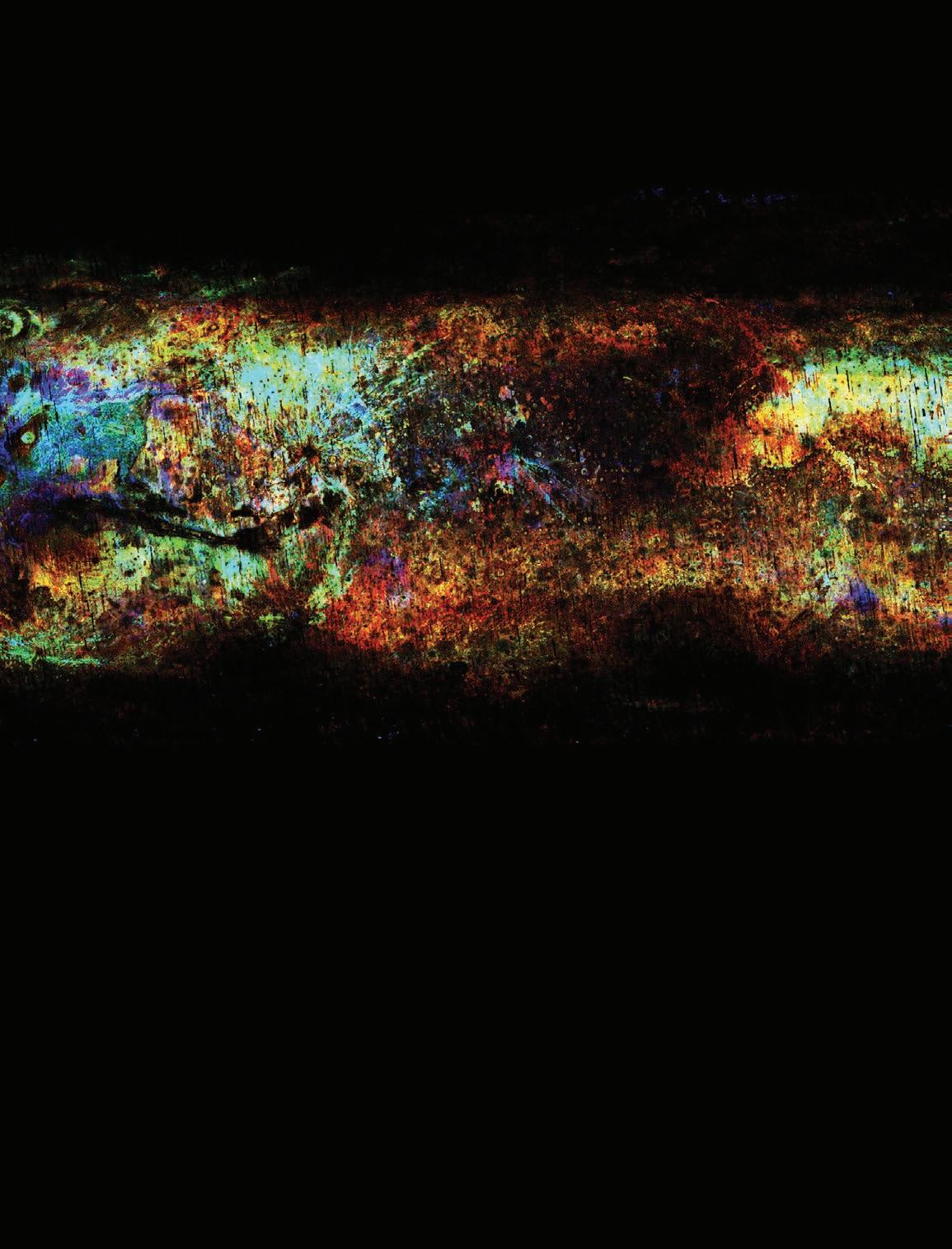
Curtin University is pushing the boundaries of space technology, advancing planetary science research and expanding our understanding of the local and distant universe.
We’re tracking remote objects, analysing the composition of planetary bodies, designing and building end-to-end satellite technologies for on-orbit missions, and managing large-scale remote observation infrastructure.
With embedded research excellence and support from trusted partners, our bold multidisciplinary research programs look to create impact, innovate and shape the future of the Australian space industry as we build our sovereign capability and capacity in the coming years.
To find out more about our programs and partnerships, visit curtin.edu/space.

OUR EXPERTISE
• Space systems engineering and remote operations
• Planetary geology, astrophysics and exploration science
• Communications, remote sensing, signal processing and navigation
• Analytics, computing and visualisation
• Robotics and automation
Image: Mars craters densitymap
Authors: Dr. Anthony Lagain(1), Prof. Gretchen Benedix(1), Mr. Konstantinos Servis(2)
(1) Space Science and Technology Centre
(2) CSIRO - Pawsey Super Computing Centre
CRICOS Provider Code 00301J. 5528ROC


Private sector drives missions to Mars
We speak with John Curtin Distinguished Professor Steven Tingay, the Executive Director of the Curtin Institute of Radio Astronomy

We speak with John Curtin Distinguished Professor Steven Tingay, the Executive Director of the Curtin Institute of Radio Astronomy, about the main reasons for wanting to go to Mars and how much demand there is to go to Mars and for what purpose. NASA has recently invited the private sector to submit proposals on commercial missions to the red planet.
Professor Tingay said - “For decades, NASA and other space agencies have spent large sums on in-house planning, development and production for space missions. In the 2020s, the technologies for space exploration are increasingly being developed in the commercial world. However, it is early days and the commercial approach has to prove itself. Should humans go to Mars? If the history of human exploration is anything to go by, you only need a tiny fraction of the population to be motivated enough to do it. If they also have the capital, it will happen.”
WATCH NOW
SCAN HERE For more of the latest news and interviews in space sector! or head to www.australiainspace.com.au/tv
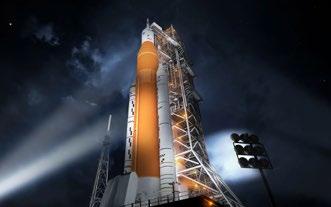





4 | Australia in Space Magazine Contents Sam Forbes: Pioneering the Future of Space Operations through the Eisenhower Fellowship 8 NASA delays Artemis II & III, heatshield issues to overcome 10 NASA selects companies to advance moon mobility 14 Why Australia’s Sunshine Coast was chosen for the Australian Geospatial Intelligence Centre of Excellence. 16 Australia in Space: A capability lens 20 REGIONAL FOCUS SERIES Indo-Pacific space launches heat up in 2024 26 Malaysia keen to make its mark in the global space sector 28 China’s new Antarctic base may monitor Australian space launches 30 Australian space start ups continue to attract investor funding 32 India releases FY2024/25 space launch schedule 33 Unlocking the mysteries of microgravity: South Australian titans forge new space frontiers! 34 Endeavour Scholarship launches first Polish team to U.S. space camp 36 Hubble spies water on exoplanet 97 light years away 38 A Physiotherapy student advancing the Australian Space medicine workforce 40 The Company on a mission to change the perception of space 42 Contents 10 30 38 46 Dharshun Sridharan Nipuni Silva Chris Meyer Euro Consult Cambrian Executive Rorisang Moyo *Cover Image AI Generated using midjourney V6.0 CONTRIBUTORS | ORGANISATIONS English and U.S spelling may be adopted subject to print location and author preference OUR SPACE CHANNELS Director & Executive Editor Chris Cubbage General Manager –Industry Engagement Jessica Bainbridge Digital Content Manager MJ Yun Data Scientist Muhammad Bilal Shaikh Regional Correspondents Jane Lo - Singapore Sarosh Bana - India Andrew Curran - Australia Managing Director David Matrai Art Director Stefan Babij Senior Digital Designer Melissa ten Bohmer Digital Content Senior Editor Sarah El-Moselhi MARKETING AND ADVERTISING promoteme@mysecuritymedia.com Copyright © 2024 - My Security Media Pty Ltd GPO Box 930 SYDNEY N.S.W 2001, AUSTRALIA E: promoteme@mysecuritymedia.com All material appearing in Australian in Space Magazine is copyright. Reproduction in whole or part is not permitted without permission in writing from the publisher. The views of contributors are not necessarily those of the publisher. Professional advice should be sought before applying the information to particular circumstances. RETURNING IN 2024 www.spaceandearthconference.com

Welcome to our first edition of the year and timed for the 39th Space Symposium, Colorado Springs, USA and announcing the dates for our 2nd Indo-Pacific Space and Earth Conference, 26-28 November at Crown Perth, Western Australia.
This edition follows our coverage of the Global Space & Technology Convention, Singapore, Geo Connect Asia, Singapore, and International Global Navigation Satellite Systems (IGNSS) Conference, Sydney. We are also pleased to announce a strategic media partnership with The Andy Thomas Space Foundation, organisers of the Australian Space Forum.
The space sector started 2024 at a rapid pace, with 14 launches from five countries in just the first month. January started with a launch on New Year’s Day by India’s Space Research Organisation (ISRO) and closed with Rocket Lab launching an electron rocket from their New Zealand spaceport.
ISRO’s first launch for the year (local time) used a PSLV-DL rocket, which took into orbit a X-ray astronomy satellite and a multi-experiment payload module. There were also ten attached payloads on the PSLV’s fourth stage, which will perform various experiments for Indian research institutions.
China is shooting for a record 100 space launches this year, second only to the United States, and streaking ahead of other space nations. As of March 25, the country has conducted 13 launches so far this year.
On March 20, a Long March 8 rocket carrying a Queqiao-2 satellite successfully launched from the Wenchang spaceport in the Hainan province. The satellite will act as a communications relay between ground operations on Earth and an upcoming mission to the moon’s far side.
The following day, a Long March-2D carrier rocket lifted off from the Jiuquan Satellite Launch Center in northwest China with Yunhai-2 02 satellites onboard. It was the 513th mission of the Long March carrier rocket series. Yunhai-2 is a constellation of Chinese military meteorological satellites. They will reportedly collect atmospheric data for weather prediction, ionosphere, climate, and gravity research.
This year’s planned launches are a substantial increase from the 67 launches in 2023. China’s Aerospace Science and Technology Corporation (CASC), the state-owned main contractor for the Chinese space program, is behind 70 of this year’s scheduled launches.
As in most advanced technology domains, China is increasingly active and has also opened another permanently manned research station in Antarctica, which may be used to collect signals intelligence from Australia and New Zealand, including telemetry data on rockets launched from both countries.
Chinese state media confirmed the opening of the Qinling base in February, the country’s fifth in Antarctica. However, the positioning of its newest base, on the Inexpressible Island coastline due south of Australia and New Zealand, has raised concerns about China’s intentions.
The stated purpose of Qinling is to study local ecology. However, the dual-purpose nature of such facilities, including the ability to track and communicate with objects in space, adds another layer of complexity to local rocket launches. China has begun taking a greater interest in Antarctica in recent years. Qinling will be the country’s third year-round manned base there. It will house 80 people over the summer and 30 over the winter. A purpose-built pier allows easy access for China’s Antarctic capable vessels.
In addition to supporting China’s own space program, including serving as
Chris Cubbage CPP, CISA, GAICD Director & Executive Editor

reference stations for their dual-use BeiDou satellite navigation network, the involvement of China Aerospace Science and Industry Corporation (CASIC), a major player in China’s space sector, in the communications installations at the bases, has raised concerns China’s space agenda in the Antarctic is more than just domestic.
In February, India amended its direct foreign investment rules surrounding the space sector. The Indian government decision to relax direct foreign investment rules in the country’s space industry will be pivotal to achieving an 8% global market share of the space sector by 2033, according to leading local space entities. Until now, it has only been allowed with government approval. But critics said the rule held back the growth of India’s space industry. Under the new regime, manufacturers of satellite components, their systems/ subsystems, and associated ground systems and user systems can secure 100% direct foreign investment without government approval. Manufactures and operators of satellites and spaceports and associated systems or subsystems, can secure incrementally reduced funding through direct foreign investment without government approval, though most will still requires clearance.
India’s space industry shot to prominence last August when it executed a soft landing of a spacecraft near the Moon’s unexplored South Pole region – the first country to touch down in the zone. The country’s space sector is presently valued at around USD8.5 billion, constituting around 2% of the global space economy. On its current trajectory, the domestic space sector’s valuation is tipped to reach approximately USD44 billion by 2033, or 8% of the global space economy.
Closer to home, a treaty-level agreement between Australia and the United States was tabled in the Australian Parliament on February 28, paving the way for the US government and private entities to undertake space launch activities in Australia. The Technology Safeguards Agreement (TSA) sets down the legal and technical framework to facilitate the correct handling of sensitive technologies and support the launch of US space launch vehicles and satellites in other countries.
The TSA will allow US space technology like rockets and satellites to be launched from Australia. This, in turn, is intended to make Australia more attractive as a global launch hub and potentially supporting growth across the entire supply chain.
Out of the four strategic pillars identified in Australia’s 2019–2028 civil space strategy, in this issue, Dharshun Sridharan analyses the second and as our feature cover – 'Develop national capability.' This pillar is critical to the nation’s space sector. There are competing priorities, all crucial to different stakeholders. More importantly, there is little overlap.
The insights from the recent Defence Strategic Review (DSR), coupled with AUKUS priorities, along with the nation's civil sectors like Health and Education, and amidst global economic uncertainties and tensions, significantly affect capital investment availability, thereby impacting workforce capabilities and capacity. When the goals of the Space Sector become interwoven with other key priorities, the path to achievement becomes increasingly intricate and complex.
As always, we cover the full diversity of the Australian and international space industry and there is so much more to touch on, including live, embedded content in this digital edition. Enjoy the reading, watching and listening.
Australia in Space Magazine | 5
Desk
Editor's

TAKEAWAY
Highlight interviews from the Global Space and Technology Convention

UK Space Agency and the Southeast Asian
We speak with Professor Anu Ojha OBE, Director for Championing Space, United Kingdom Space Agency

The UK is a long-term strategic partner for Singapore Space and Technology Limited and the Global Space and Technology Convention. Our partnership began in 2022, where Singapore Space and Technology Limited inked an agreement with the UK Science and Technology Facilities Council (STFC) to encourage two-way deal-flows between Singapore and the UK. The partnership has grown each year, marked by significant initiatives:
• A rideshare agreement to make space exploration, research and development more accessible, and
• Real-time monitoring services for the steel industry – a fundamental step in tracking Earth’s resources and moving our sustainability agenda forward.
WATCH NOW
SCAN HERE For more of the latest news and interviews in space sector! or head to www.australiainspace.com.au/tv 6 | Australia in Space Magazine


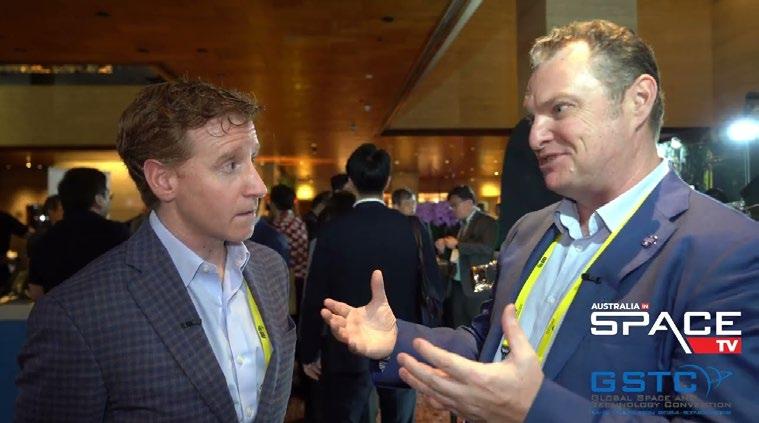
Geospatial information is a key enabler to ensure cities are safe and sustainable
Interview with Dr Naoko Sugita, International Coordination Officer and Advisor to the Director, Earth Observation Research Center, Japan Aerospace Exploration Agency (JAXA)

Faraday Dragon rideshare satellite programme
Interview with Peter Stocken, Business Development Manager for In-Space Missions Ltd, a wholly owned subsidiary of BAE Systems
Space-based radio frequency mapping
Interview with John Serafini, Chief Executive Officer of HawkEye 360, a leading developer of space-based radio frequency (RF) mapping and analytics capabilities
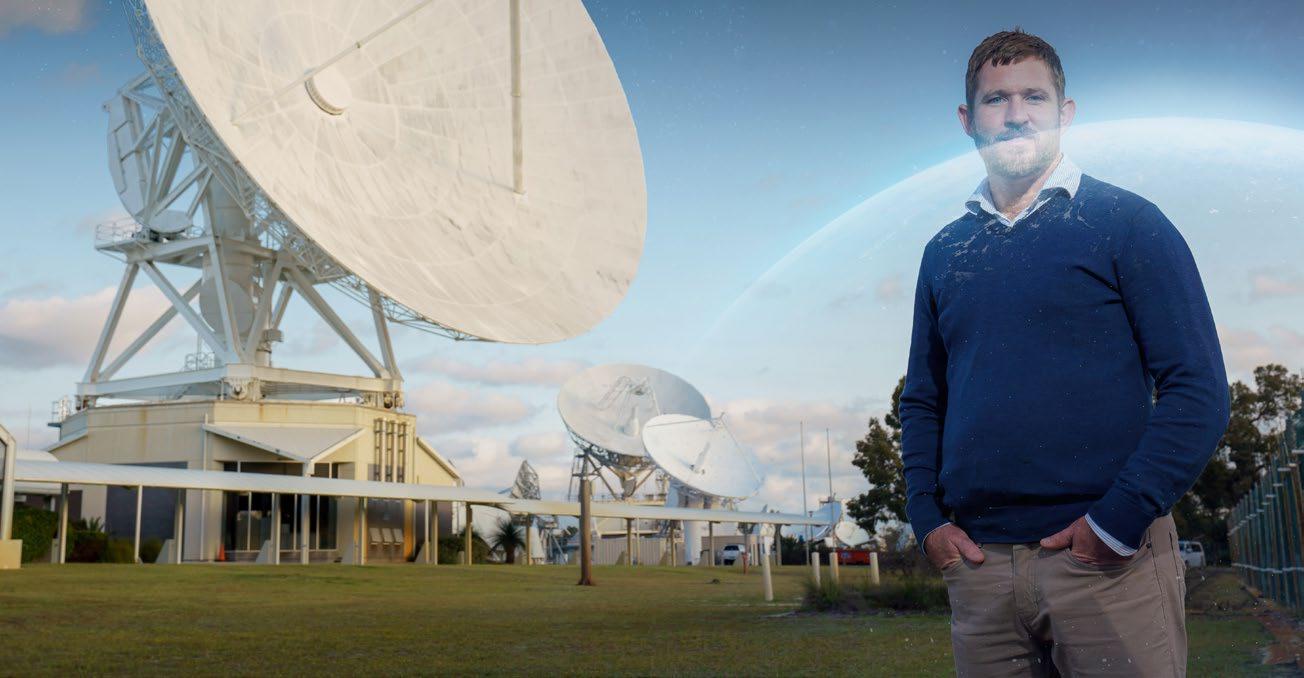
Sam Forbes: Pioneering the Future of Space Operations through the Eisenhower Fellowship

In the realm of aerospace innovation, where the boundaries of human ingenuity and technological advancement converge, Australian visionary Sam Forbes is making significant strides. As the Director of the Space Automation, AI, and Robotics Control Complex (SpAARC) in Perth, Sam has been at the forefront of pioneering a new business model that revolutionises space mission operations. His leadership at SPAARC focuses on leveraging cutting-edge automation, artificial intelligence, and robotics to enhance efficiency and sustainability in space missions, underscoring Australia's growing influence in the global aerospace sector.
Forbes' commitment to advancing Australia's role in space exploration has been recognised on the international stage through his recent selection for the prestigious Eisenhower Fellowships. Chaired by former U.S. Secretary of Defense Robert Gates, this program is renowned for its rigorous selection process, identifying and empowering global leaders poised to create impactful change. For Sam, the fellowship represents an unparalleled opportunity to engage with world-renowned experts, explore innovative practices, and foster international collaborations that could shape the future trajectory of space operations.
During his six-week journey in the United States,


Sam is slated to engage with an array of leaders and pioneers across the aerospace industry. His itinerary includes strategic meetings in key locations such as Pasadena, San Francisco, Texas, and New York, where he aims to exchange ideas and glean insights from the epicenters of aerospace innovation. By understanding the perspectives and strategies of these industry leaders, Sam aims to incorporate broader, more diverse insights into SpAARC's operations, ultimately driving forward Australia's contribution to the global space ecosystem.
As the space industry stands on the cusp of a new era of exploration and commercialisation, leaders like Sam Forbes are pivotal in ensuring that Australia not only participates but thrives in this interstellar journey. His tenure as an Eisenhower Fellow is set to be a transformative experience, not just for him personally but for the broader Australian space community, heralding a future where the nation's space sector reaches new heights of innovation and collaboration.
As we anticipate the outcomes of Sam’s fellowship and the ensuing advancements for SpAARC and the Australian space industry, it is clear that his journey embodies the spirit of exploration and discovery that propels humanity toward the stars.
8 | Australia in Space Magazine
AUSTRALIA IN SPACE
Courtesy of Fugro SpAARC










OFFICIAL GOVERNMENT CYBERSECURITY PARTNER HOSTED BY CYBER SECURITY COUNCIL ﻲﻧاﺮﺒﻴﺴﻟا ﻦﻣﻷا ﺲﻠﺠﻣ OFFICIALLY SUPPORTED BY OFFICIAL DISTRIBUTION PARTNER LEAD STRATEGIC PARTNER STRATEGIC PARTNER PLATINUM SPONSOR GOLD SPONSOR BRONZE SPONSOR 23-25 APR 2024 DUBAI WORLD TRADE CENTRE #gisecglobal | gisec.ae SCAN HERE THE SUPER CONNECTOR EVENT FOR THE MIDDLE EAST & AFRICA'S CYBERSECURITY COMMUNITY AI-DRIVEN CYBER RESILIENCE A BOLD NEW FUTURE gisec@dwtc.com | Tel: +971 4 308 6469 GET INVOLVED
NASA delays Artemis II and III, heatshield issues to overcome
 By Andrew Curran Australia in Space
By Andrew Curran Australia in Space
NASA has delayed Artemis II until September 2025 and Artemis III until September 2027 to overcome the technical and logistical challenges of returning humans to the Moon.
NASA Administrator Bill Nelson confirmed the delays during a media briefing on January 10, 2024 (Sydney time).
“Safety is our top priority,” he said. “We’re going to give our Artemis teams more time to work through the challenges and we’re adjusting our schedule.”
Artemis is NASA’s marque program to send humans back to the Moon’s surface and beyond. Artemis II aims to put humans on the Moon for the first time since 1972, while Artemis III intends to land astronauts near the lunar South Pole. However, cost overruns and delays – today’s announcement being the latest, have beset the USD100 billion program. Nelson says Artemis IV, the first mission to the Gateway lunar space station, retains its September 2028 target.
Having successfully conducted the uncrewed Artemis I mission in November 2022 after multiple delays caused by pre-flight test difficulties. Artemis I completed two fly-bys of the Moon. The mission also gathered vital intelligence on the performance of the Orion spacecraft, especially its heat shield, for use in later Artemis missions.
Amit Kshatriya, NASA’s Deputy Associate Administrator, Moon to Mars Program, Exploration Systems Development Mission Directorate, said data from Artemis I is having a big impact on the development of the Artemis II and III missions.
“We got a tremendous amount of engineering data from Artemis I,” he said. “We also learned a lot about the production about the production and assembly of components for Artemis II and III. One major finding is that we need more time to work on the performance of the
thermal protection shielding.”
While the Lockheed Martin-manufactured heat shields on Artemis I performed within the prescribed safety margins, and the re-entry performed well. “What we did see in the performance of the heat shield was some unexpected phenomena. We did see the off-nominal recession of some char that came off the heat shield, which we were not expecting.”
“The heat shield is an ablative material. It is supposed to char, but we were not expecting to see pieces of that char to be liberated from the vehicle. We need to understand what happened and have spent most of 2023 investigating the issue.”
Kshatriya stressed that had the flight been crewed by humans, the heat shield issue would not have posed a threat to them. “There would not have been any disturbance inside the vehicle,” he said.
Separate from the heat shield issue, Kshatriya said Orion’s integrated abort capability required more work. He said the qualification process uncovered some deficiencies in the performance of the electrical system, including the ability of some of the batteries to withstand the hostile environment. “We have not yet developed a forward path, but we have multiple parallel options to fix this issue,” he said.
Kshatriya denied future Artemis launch dates were merely aspirational and said the latest delays will not change the mission profile. Instead, the delays simply prioritised crew safety. “We’ve tried to address the unknown unknowns,” he said. “We’ve looked at all the steps to get to launch in September 2025 and again in 2026. The crew want to see a realistic path that gives them the best way forward.”
10 | Australia in Space Magazine


International Global Navigation Satellite Systems (IGNSS)
We speak with Matt Higgins, President of the International Global Navigation Satellite Systems (IGNSS) Association. SCAN HERE
For more of the latest news and interviews in space sector!

The IGNSS Association is a not-for-profit association servicing a wide international network of academics, industry and professionals, and is headquartered in Sydney, Australia. Our mission is to provide a member oriented, market driven association, through activities such as workshops and conferences. What sets us apart is our is our emphasis on bringing together and providing a platform for cutting-edge academic research, service providers and government bodies, and industry R&D achievements from companies both big and small.
The IGNSS Association runs the bi-annual IGNSS conference, which is the premier conference on Global Navigation Satellite Systems (GNSS) and related Position, Navigation and Timing (PNT) technologies in the Australasian region.
For more information visit https://www.ignss.org.au/about
WATCH NOW
or head to www.australiainspace.com.au/tv


GNSS Analysis software updated on Github by GeoScience Australia - IGNSS24
We speak with Dr Anna Riddel, Director, GNSS Analysis at Geoscience Australia

Ginan delivers a real-time positioning correction service and additional positioning products through open-source software, to enable precise point positioning.
Within the NPIC ecosystem, Ginan is being used to validate and verify the quality of data coming from the NPIC network, ensuring that consumers are only accessing data that can be trusted.
Ginan is also being used to generate models of error sources in real-time that are broadcast over the internet as an openly accessible correction service - available for research and innovation.
Geoscience Australia's GitHub page provides access to the latest version of Ginan. Please be aware that the developers continuously update this software with new functionality and quality improvements.
WATCH NOW
or head to www.australiainspace.com.au/tv
SCAN HERE For more of the latest news and interviews in space sector!

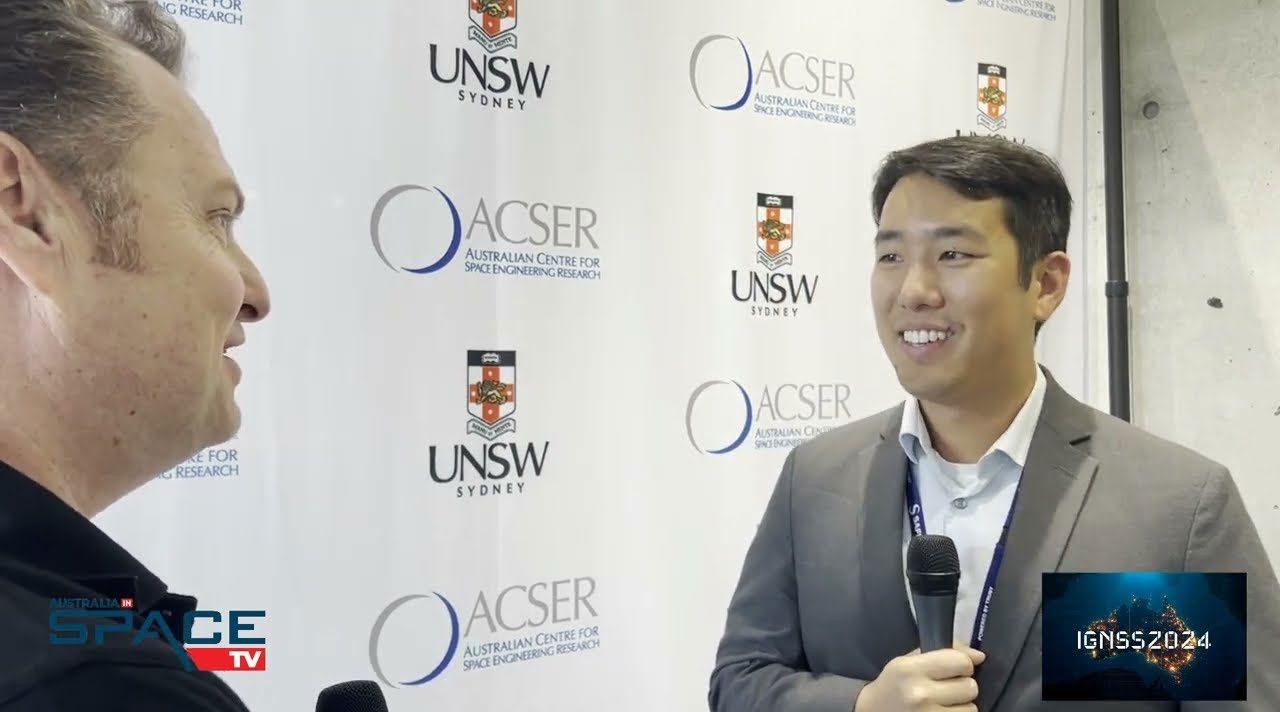
Bryan Chan is co-founder and VP of Business Development and Strategy at Xona Space Systems. He has over 12 years experience in the aerospace industry, spanning technical roles in government organizations to executive leadership positions at start-up companies. Prior to Xona Bryan worked at Maxar Technologies managing GEO communications satellite programs. He also served as the CEO of Night Crew Labs, conducting research on GPS radio occultation methods on aerial platforms for NASA and NOAA.

Bryan Chan is co-founder and VP of Business Development and Strategy at Xona Space Systems
Mr. Chan previously held engineering roles at the NASA Jet Propulsion Laboratory, NASA Ames, and SpaceX. He received his B.S. in aerospace engineering at Georgia Institute of Technology, and his M.S. degree in aerospace engineering at Stanford University.
WATCH NOW
Delivering a new generation of LEO PNT satellites
SCAN HERE For more of the latest news and interviews in space sector! or head to www.australiainspace.com.au/tv

NASA selects companies to advance moon mobility
NASA has selected Intuitive Machines, Lunar Outpost, and Venturi Astrolab to advance capabilities for a lunar terrain vehicle (LTV) that Artemis astronauts will use to travel around the lunar surface, conducting scientific research during the agency’s Artemis campaign at the Moon and preparing for human missions to Mars.
The awards leverage NASA’s expertise in developing and operating rovers to build commercial capabilities that support scientific discovery and long-term human exploration on the Moon. NASA intends to begin using the LTV for crewed operations during Artemis V.
“We look forward to the development of the Artemis generation lunar exploration vehicle to help us advance what we learn at the Moon,” said Vanessa Wyche, director of NASA’s Johnson Space Center in Houston. “This vehicle will greatly increase our astronauts’ ability to explore and conduct science on the lunar surface while also serving as a science platform between crewed missions.”
NASA will acquire the LTV as a service from industry. The indefinite-delivery/indefinite-quantity, milestonebased Lunar Terrain Vehicle Services contract with firmfixed-price task orders has a combined maximum potential value of $4.6 billion for all awards.
Each provider will begin with a feasibility task order, which will be a year-long special study to develop a system that meets NASA’s requirements through the preliminary design maturity project phase. The agency will issue a subsequent request for task order proposal to eligible provider(s) for a demonstration mission to continue developing the LTV, deliver it to the surface of the Moon, and validate its performance and safety ahead of Artemis V. NASA anticipates making an award to only one provider for the demonstration. NASA will issue additional task orders to provide unpressurized rover capabilities for the agency’s moonwalking and scientific exploration needs through 2039.
The LTV will be able to handle the extreme conditions at the Moon’s South Pole and will feature advanced
technologies for power management, autonomous driving, and state of the art communications and navigation systems. Crews will use the LTV to explore, transport scientific equipment, and collect samples of the lunar surface, much farther than they could on foot, enabling increased science returns.
Between Artemis missions, when crews are not on the Moon, the LTV will operate remotely to support NASA’s scientific objectives as needed. Outside those times, the provider will have the ability to use their LTV for commercial lunar surface activities unrelated to NASA missions.
“We will use the LTV to travel to locations we might not otherwise be able to reach on foot, increasing our ability to explore and make new scientific discoveries,” said Jacob Bleacher, chief exploration scientist in the Exploration Systems Development Mission Directorate at NASA Headquarters in Washington. “With the Artemis crewed missions, and during remote operations when there is not a crew on the surface, we are enabling science and discovery on the Moon year around.”
NASA provided technical requirements, capabilities, and safety standards needed for LTV development and operations, and the selected companies have agreed to meet the key agency requirements. The contract request for proposal required each provider to propose a solution to provide end-to-end services, including LTV development, delivery to the Moon, and execution of operations on the lunar surface.
Through Artemis, NASA will send astronauts – including the first woman, first person of color, and its first international partner astronaut – to explore the Moon for scientific discovery, technology evolution, economic benefits, and to build the foundation for crewed missions to Mars. Advanced rovers, along with the agency’s SLS (Space Launch System) rocket and Orion spacecraft, commercial human landing systems and next-generation spacesuits, and Gateway are NASA’s foundation for deep space exploration.
14 | Australia in Space Magazine AUSTRALIA IN SPACE
Courtesy of NASA

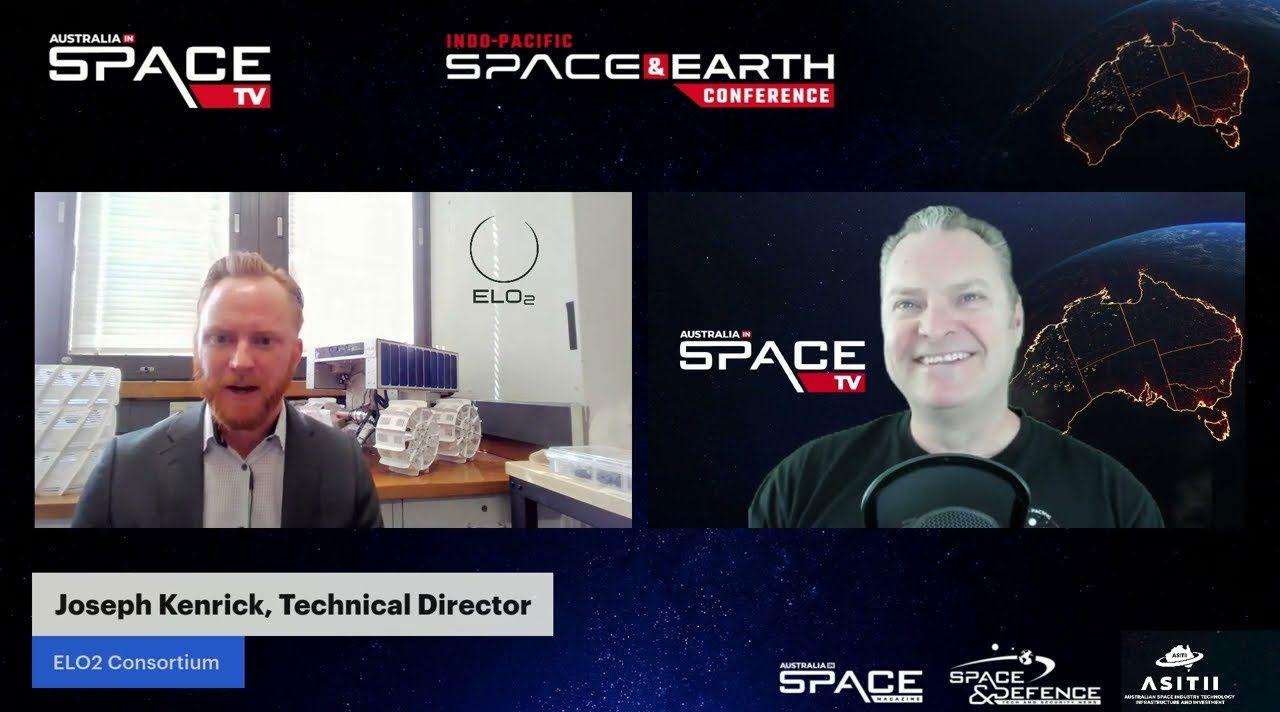
Lunar Rover: Made in Australia, going to the Moon
We speak with ELO2 Technical Director with Lunar Outpost
Oceania, Joseph Kenrick. SCAN HERE
For more of the latest news and interviews in space sector!

In a ground-breaking moment for Australian space exploration, Adelaide will host the unveiling of the ELO2 Consortium’s pioneering lunar rover prototype, demonstrating Australia’s potential to support a future NASA Artemis mission to the Moon.
The working rover showcases Australia’s expertise in mining and robotics in extreme environments.
It is designed to collect and transport lunar regolith (Moon soil) to a NASArun facility on the Moon, where oxygen will be extracted to prove technology essential for a sustainable human presence on the Moon, and production of rocket fuel to support a future mission to Mars.
The ELO2 rover prototype will traverse both a lunar and Martian-like surface in Adelaide through Lunar Outpost’s lunar mission ready Stargate remote operations software, in an end-to-end remote operation demonstration.
The ELO2 Consortium is one of two Australian consortia working on the design with funding from the Australian Space Agency’s Moon to Mars Trailblazer Program Stage 1 with an ambition to land a rover, to be named Roo-ver, on the Moon as part of a future NASA Artemis mission later this decade.
WATCH NOW
or head to www.australiainspace.com.au/tv
Why Australia’s Sunshine Coast was chosen for the Australian Geospatial Intelligence Centre of Excellence.

The Sunshine Coast, Australia is emerging as a potential hub for geospatial intelligence where diverse players in the US$520 billion global industry can collaborate to explore and resolve universal problems using geospatial technology.
The concept for an Australian Geospatial Intelligence Centre of Excellence (GICoE) in the region was introduced at an ideation session of more than 40 sector representatives in late 2023 and is gathering momentum as the opportunities and potential for growth become evident.
Located just over an hour north of Brisbane, Australia’s Sunshine Coast is not only one of the country’s most beloved tourist destinations, it’s also a regional technology hub
Harnessing the potential of geospatial intelligence
Geospatial professionals analyse and interpret information about locations on Earth. Geospatial intelligence (GEOINT) contributes significantly to a wide range of industries, using geographic data to understand and address complex challenges and make informed decisions based on spatial information.
Dr Adrian McCallum is the Head of Engineering at the University of the Sunshine Coast (UniSC) where he manages courses in geotechnical engineering and weather and climate. An expert in remote area science and engineering, Dr McCallum says the Sunshine Coast has all the right ingredients to harness the potential of geospatial intelligence.
“The collection, analysis and exploitation of geospatial data is exploding in importance. So much data is available today that can be used for an almost infinite array of purposes. In parallel with the data itself is our evolving capability to utilise artificial intelligence and machine learning to extract maximum value from such data to solve problems and identify opportunities from further data leveraging,” Dr McCallum said.
Sunshine Coast is enabling the future, today
Australia’s Sunshine Coast is a tech-savvy region with a reputation for innovation. The newly developed Maroochydore City Centre was designed to incorporate the latest in data networking technology, including a city-wide deployment of fibre broadband, with Wi-Fi 6 and LoRaWAN wireless network access points and pole infrastructure.
The city centre hosts NEXTDC’s tier one data centre (SC1) providing the perfect hub to connect the Sunshine Coast’s international submarine cable with major networks and digital service providers.
“The establishment of a GICoE on the Sunshine Coast could catalyse the creation of a whole range of data management, analysis and exploitation opportunities, many of which we are probably yet to conceive. With Australia’s newest high-speed internet cable coming ashore here, our ability to transmit/receive, analyse and leverage geospatial data is second to none so establishing an Australian Geospatial Intelligence Centre of Excellence on
16 | Australia in Space Magazine
Courtesy of the Sunshine Coast City Council
AUSTRALIA IN SPACE

the Sunshine Coast now makes sense,” Dr McCallum said. Tech infrastructure the jewel in Sunshine Coast’s crown
Geospatial professional, Mark Billing, whose career in the sector spans more than 30 years, says the city centre’s tech ecosystem is a key driver for GEOINT companies to establish or conduct testing in the region. As Head of Business Expansion for global leader Geospatial Intelligence Pty Ltd, Mr Billing is currently growing the business’s Sunshine Coast operation.
“Spatial tech crosses over a range of capabilities including data analytics, big data, AI and cyber security. There’s already a network of broader surrounding capabilities that exist here on the Sunshine Coast,” Mr Billing said.
“We have instances of companies with AI or geospatial capability using data centres in Canberra and London, looking to move here to distribute around the world. They’re lured by the benefits of redundancy and latency and having everything local means better performance. Also, data sovereignty requirements often mean government agencies and private businesses want information kept in the country, especially sensitive data.”
Supportive tech ecosystem
Beyond the world-leading tech infrastructure is an exceptionally supportive local council committed to
“The collection, analysis and exploitationofgeospatialdatais exploding in importance. So much data is available today that can be used for analmostinfinitearrayofpurposes”
thinking outside of the box to establish the region as a leading smart city. Council’s support for developing revolutionary tech-led solutions is evidenced by its successful Testing Tech in Paradise program which offers technology developers, providers and manufacturers the opportunity to test and trial new technologies in a realworld environment in the new Maroochydore City Centre.
"It’s a very progressive council and seen as a leading council in terms of smart cities. The testing environment is very important if we are to stand up projects and proofs of concept. There isn’t really any place better to do that sort of thing,” said Mr Billing.
Genesis of a Geospatial Intelligence Centre of Excellence
The well-attended ideation arranged by Sunshine Coast Council and Geospatial Intelligence Pty Ltd late last year spawned interest in creating an Australian Geospatial Centre of Excellence to leverage the Sunshine Coast’s tech infrastructure to attract geospatial projects to the region.
A call for expressions of interest for a GICoE Steering Committee attracted around 40 applications from a broad cross-section of the sector, with the next step a meeting of the newly appointed steering committee which will be initially led by Mr Billing. The committee will establish clear objectives for the centre, aligned with broader goals of advancing geospatial technology, fostering education and driving economic growth.
An invitation to collaborate and showcase capability
“GICoE intends to establish a coalition of capability through the development of a critical mass of regional geospatial expertise,” Mark Billing explains.
“We’ll be developing strategies for attracting geospatial projects, showcasing the unique regional competency and capabilities of the centre as well as exploring funding opportunities, partnerships and revenue streams. We are enthusiastic about creating a network of partners who can work together on new projects and invite anyone interested in becoming involved to get in touch.”
GICoE is seeking to collaborate with industry, research organisations and government and would particularly like to hear from professionals in sectors that haven’t been heavily involved to date, including defence (both uniformed and civilian), agricultural and land management, logistics and transport.
Cont next page >>
AUSTRALIA IN SPACE Australia in Space Magazine | 17


With a geospatial career spanning over 30 years, Mark Billing is passionate about the difference geospatial technology can make in businesses and within the broader community. Having a reputation as a highly accomplished executive business leader, Billing has established a broad network of strong relationships across diverse sectors throughout
UniSC already plays a pivotal role in fostering and translating research within the region, enabling local, national and global impact. The university holds extensive networks across many research areas pertinent to GICoE. It is expected to work with the centre and Sunshine Coast Council to bring stakeholders together, support data collection and analysis and feed the growing sector with emerging GEOINT professionals.
Attracting and developing tech talent
A key role of the GICoE will be to develop a plan to attract and retain talent, leveraging the robust STEM programs in local high schools as well as UniSCs international leadership and research strengths. UniSC offers many undergraduate and postgraduate programs that align with a Geospatial Intelligence Centre of Excellence, including School of Science, Technology and Engineering programs across Science, Engineering, IT and Cybersecurity.
“Talent acquisition and retention is a problem that all industries, particularly tech industries are facing at the moment,” Dr McCallum explains.
“The Centre of Excellence and UniSC would need to provide pathways to opportunities in this area but the opportunities must exist beforehand. Not everyone is familiar with the term Geospatial Intelligence. Demystifying the language and educating our communities on the opportunities is essential if we are to encourage growth in this field; growth to which we can ultimately direct homegrown and locally nurtured pipelines of talent.
“The nexus of a forward-thinking regional council, advanced, proven industry partners with an agile and growing university on the doorstep of Australia’s newest international fibre optic submarine cable, makes the Sunshine Coast a prime location for an Australian Geospatial Intelligence Centre of Excellence.
“In an increasingly data-driven world, all geospatially evident industries would benefit from the collection, analysis and leveraging of geo-spatiotemporal data. The Sunshine Coast has the tools, the expertise and the ardour to leverage such capability for the benefit of the region and the nation,” Dr McCallum said.
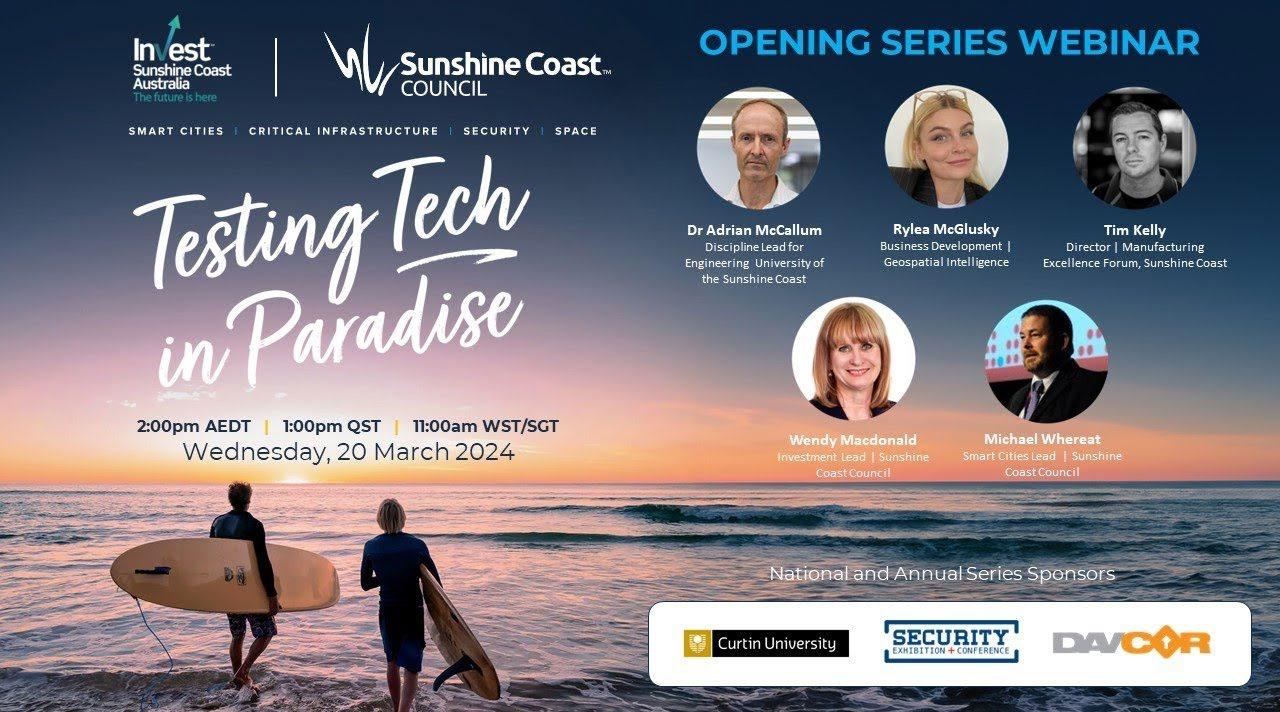
18 | Australia in Space Magazine
AUSTRALIA IN SPACE
McCallum currently serves as Head of Engineering at University of the Sunshine Coast and manages courses in geotechnical engineering and weather and climate. He is fortunate to have led a life of adventure and exploration around the globe and is an expert in remote area science & engineering.
the Asia Pacific region.
Dr Adrian McCallum
Mark Billing


ON LOCATION EVENT
ALTITUDE NINE ROOFTOP FUNCTION & EVENT VENUE
Corner First Ave And South Sea Islander Way, Maroochydore QLD Wednesday 3 July 2024 | 4:30pm – 7:30pm
PANEL SESSION






 Gerrit OlivierChief SCIENTIST FLEET SPACE
Peter Williams GENERAL MANAGER OF SALES SOUTHERN LAUNCH
Tim Kelly DIRECTOR MEF-SC
Simon Webster EXECUTIVE MANAGERADVANCE CAPABILITY QUEENSLAND FIRE AND EMERGENCY SERVICES
Gerrit OlivierChief SCIENTIST FLEET SPACE
Peter Williams GENERAL MANAGER OF SALES SOUTHERN LAUNCH
Tim Kelly DIRECTOR MEF-SC
Simon Webster EXECUTIVE MANAGERADVANCE CAPABILITY QUEENSLAND FIRE AND EMERGENCY SERVICES
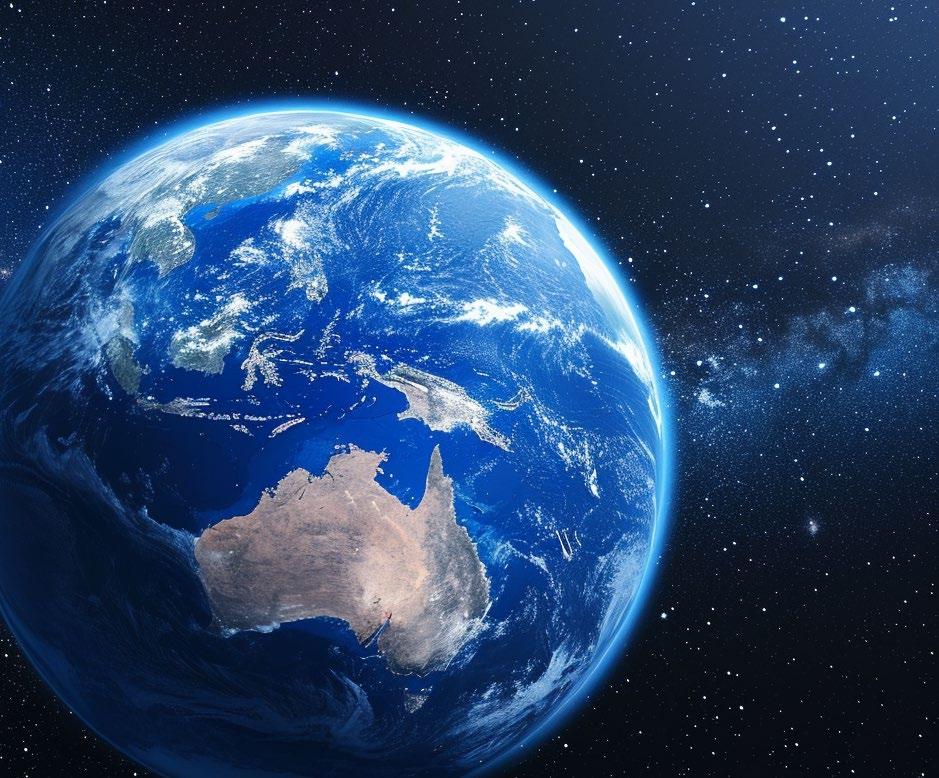
Australia in Space: A capability lens
By Dharshun Sridharan and Nipuni Silva Piston Labs
The official start of the Space Race is often considered to be October 4, 1957, when the Soviet Union successfully launched the first artificial satellite, Sputnik 1, into orbit. This event marked the beginning of the space age and initiated significant developments and achievements by countries around the world, notably the United States and the Soviet Union. Fast forward from humanity’s mo st significant achievement, NASA’s Apollo 11 mission, and we arrive at the beginning of 2024, a mere handful of years since the establishment of the Australian Space Agency. Although Australia may not have the same level of capital investment as the United States or India, or the critical mass to compete at the highest level, the nation boasts a rich history of supporting major global space programs.
Out of the four strategic pillars identified in Australia’s 2019–2028 civil space strategy, this article aims to analyse the second – 'Develop national capability.' This pillar is critical to the nation’s space sector. There are competing priorities, all crucial to different stakeholders. More importantly, there is little overlap. The insights from the recent Defence Strategic Review (DSR), coupled with AUKUS
priorities, along with the nation's civil sectors like Health and Education, and amidst global economic uncertainties and tensions, significantly affect capital investment availability, thereby impacting workforce capabilities and capacity, directly or indirectly (Figure 1). So, when the goals of the Space Sector become interwoven with other key priorities, the path to achievement becomes increasingly intricate and complex.
Globally, Australia is behind the eight-ball in the space sector. With competing priorities and a stretched workforce, the nation is at risk of falling further behind. Resetting is not impossible, and crossroads like this are not necessarily a negative, but coming out on top is complex. Australia needs to rethink its workforce development approach – a slight commercial pivot.
Despite commentary suggesting that Australia may be lagging in the space sector, there is reason to believe that the potential to accelerate, or 'Leapfrog (R&D),' is quite high. Unlike the early days of the space age when agencies and organisations tried to do everything, Australia retains a competitive advantage in understanding the global supply and demand characteristics of the sector.
20 | Australia in Space Magazine
COVER FEATURE
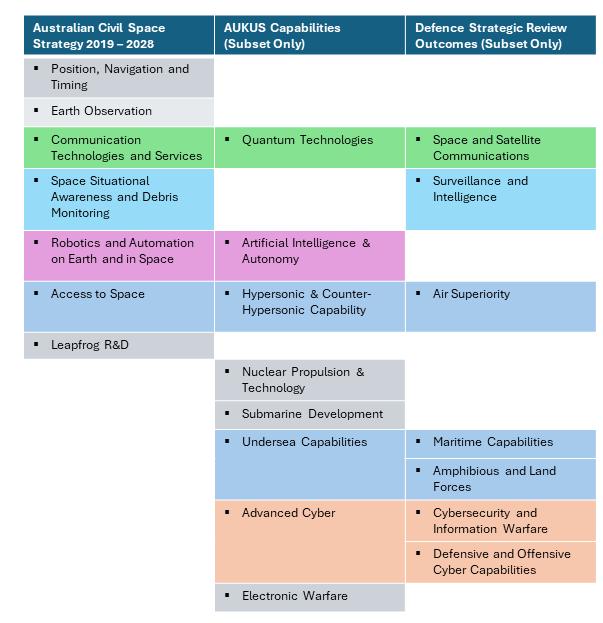
A very high-level depiction of three recently highlighted sources of capability that are arguably of equal importance with little to no overlap in areas.

This is designed to be a cyclical process of maturing whereby an initial investment towards existing capabilities produces returns that can be reinvested into new, emerging or priority capabilities.
Additionally, Australia comprehends the sectors and capabilities that already exist within the country, which can be leveraged for immediate use. The best example of this is the resources sector and its capabilities in remote operations, automation, and robotics. However, this is just one of the strategic objectives earmarked by the Agency. There are others, and although we may not possess capabilities that are all world-class standard, there is an approach that can close the gap.
The preceding depiction primarily emphasises capability building within civil contexts. However, certain high-priority areas necessitate immediate attention, introducing an additional dimension of consideration (Figure 2). Such areas may be associated with defence and national security, warranting a separate yet interconnected strategy. While this article does not delve into this aspect in detail, a suggested approach, to be explored further in subsequent articles, is provided below. It is crucial to underscore the importance of integrating such a framework with a capability development approach to ensure the success and efficacy of the notion of dual-use.
Tailoring it for Australia’s space sector transforms the approach into one of complexity. This approach recognises Australia’s world-class capabilities in areas such as Remote Operations, Robotics, and Automation, aligning with one of the Agency's focus areas. This field encompasses various sub streams, including advanced manufacturing and emerging technologies like Artificial Intelligence. Investing in these areas would yield positive returns, which can be channelled into the next capability. Based on the nation’s history, this next capability would be in the realm of Earth Observation (Figure 3).
The following diagram outlines a potential high-level approach for capability development, to be considered within the broader context of the Investment Cycle and Procurement Strategy, in conjunction with the combined focus areas (e.g., with AUKUS and the DSR). It is essential to emphasise that all these areas are crucial. The key lies in coordinating a strategy to enable and fulfill the nation’s vision in a manner that is sustainable and profitable.
The approach to capability development is not solely limited to the heightened priorities (i.e. defence), but also extends to the cultivation of areas that may be of interest to individuals or organisations. In an emerging space sector like Australia's, it is imperative not to suppress interest or support for domains that may not align with national focus (e.g., space medicine). The above merely outlines a typical approach to nurturing capability growth on a national scale. The challenge facing Australia is not unique; it is a shared challenge experienced by nations worldwide, regardless of their specific national visions, whether space-related or not. In the context of the space sector, it is crucial to step back and recognise a fundamental reality. Space is a global domain, not the exclusive territory of any single state, territory, or nation, unlike airspace, which is sovereign over the territory it covers.
Acknowledging this fundamental fact is the initial step in addressing this complex challenge. No single nation possesses all the capabilities needed to establish itself as a space power, whether in civil or defence contexts.
AUSTRALIA IN SPACE Australia in Space Magazine | 21
Cont next page >>
Figure 1: Competing priorities across competing programs
Figure 2: Generic re-investment cycle

Instead, every nation contributes as a piece to a broader puzzle. Together, the world collectively becomes a space power. While this might seem like a cliché, it remains a factual reality (disregarding geopolitical considerations). The second step, which an emerging space nation like Australia can seize, is the optimisation of the limited capital investment available. This opportunity should prioritise ventures that can lead to initial profit generation; harnessing existing world-class capabilities. These profits can then be reinvested into the space ecosystem to empower a future workforce to explore newer or weaker areas of national capability.
This approach (Figure 4) represents more than just a roadmap; it is a call for strategic advancement in how Australia's approaches all things Space. While acknowledging the diverse viewpoints of stakeholders regarding capability prioritisation and investments, this strategy offers an alternative perspective in realising Australia's vision in space. As we move into 2024, Australia's role in space, building on the legacy of the Space Race since 1957, is pivotal. Our strategic focus on developing unique capabilities positions Australia not just as a participant but as a key innovator in the evolving narrative of space exploration. This vision extends beyond national borders, contributing significantly to humanity's collective journey in space.

AUSTRALIA IN SPACE 22 | Australia in Space Magazine
Figure 4: An example of a capability-and-investment led approach
Figure 3: High level procurement vs capability-build strategy

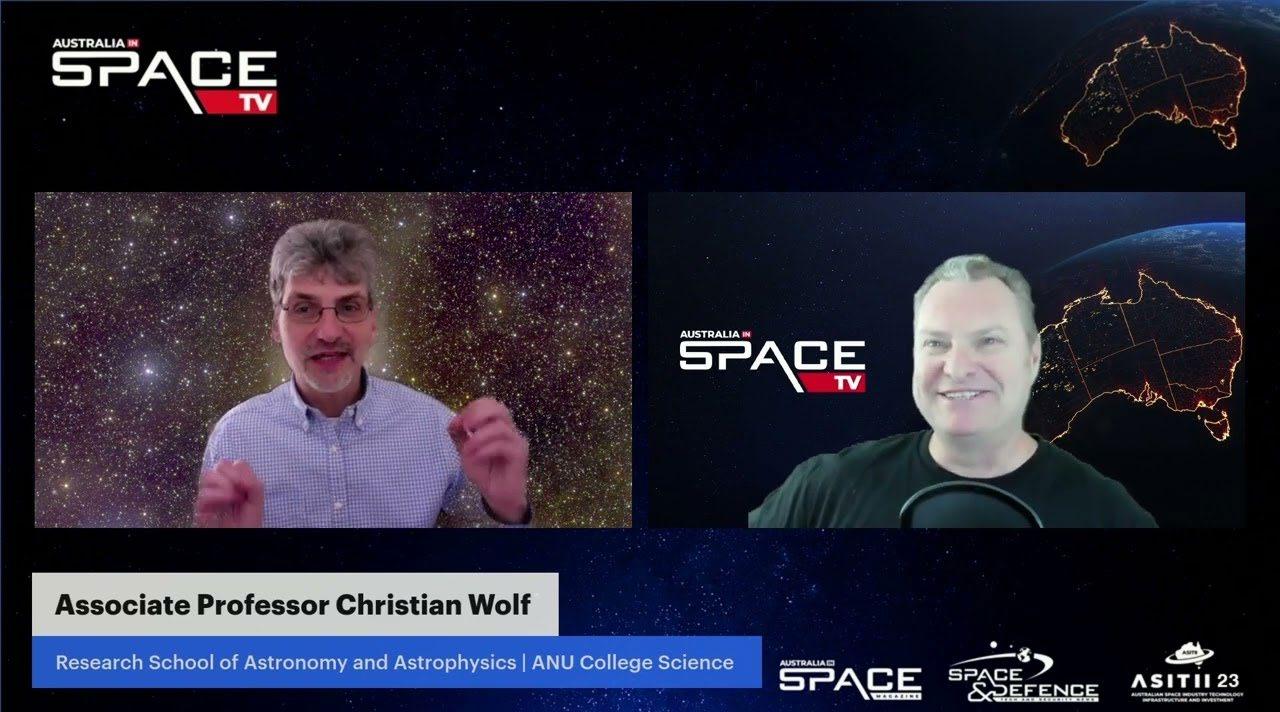
Monster black hole devouring one sun every day
We speak to lead author Associate Professor Christian Wolf, Research School of Astronomy and Astrophysics, ANU College of Science.

The fastest-growing black hole ever recorded – devouring the equivalent of one sun every day – has been discovered by researchers at The Australian National University (ANU).
The research was done in collaboration with the European Southern Observatory, University of Melbourne and the Sorbonne Université in France.
To stay in touch with the RSAA MT Stromlo site visit https://rsaa.anu.edu.au
WATCH NOW
SCAN
For more
or head to www.australiainspace.com.au/tv
HERE
of the latest news and interviews in space sector!



US-Australia space business agreement in place for lift-off
We speak with Joel Lisk, Research Associate (Space and Regulation) at the Jeff Bleich Centre for Democracy and Disruptive Technologies at Flinders University
SCAN HERE
For more of the latest news and interviews in space sector!

Australia's new Technology Safeguards Agreement will play an important role in Australia’s cooperation with the US, strengthening the ties we have with the US related to sensitive technologies, including the growing AUKUS relationship.
The implementation of this agreement will be essential to determining whether it is a useful instrument or just an agreement that will never be used.
At the same time, its implementation will need to be carefully considered to ensure it does not have an oppressive impact on start-up and growing Australian businesses that outweighs the benefits of this TSA.
This week the Australian Government released the wording of the Technology Safeguards Agreement (TSA) it signed with the US Government in October last year. The agreement will allow US companies to bring their rocket technology to Australia.
This treaty-level agreement will allow for space-businesses in the US to look to Australia as a potential location to launch their rockets and satellites. With four launch sites either established or under construction in Australia, this means we might get to see more US space businesses look to Australia as a viable place to operate from.
WATCH NOW
or head to www.australiainspace.com.au/tv

Indo-Pacific space launches heat up in 2024
By Andrew Curran Australia in Space
2024 is shaping up as a bumper year for space launches, with government space agencies and private operators crowding the launch schedule. While attention often focuses on what's launching in the North American and European markets, closer to home, in the Indo-Pacific, there are several launches and countries worth watching in 2024.
In Australia, two launches are likely within the next six months, including Gilmour Space Technologies' Eris rocket from their Queensland spaceport and HyImpulse's SR75 rocket launch from the Koonibba Test Range outside Ceduna, which the Koonibba Community Aboriginal Corporation operates in conjunction with Southern Launch.
Near neighbour Indonesia continues its gradual stepup of space sector activity this year, including sending the Telkomsat HTS 113BT satellite into orbit in February via a Falcon 9 rocket from Cape Canaveral. The satellite plugs a gap in the country's low Earth orbit telecommunications network after its predecessor was lost in a 2020 launch failure.
India preps for first crewed space mission in 2025
After conducting seven launches in 2023, the Indian Space Research Organisation (ISRO) is planning 12 launches in 2024, including several test flights to prepare for India's first crewed mission into space, dubbed Gaganyaan, and scheduled to happen sometime in 2025.
"We have a lot of research-oriented spacecraft launches which will cater to scientists and exploration of research along with four to five launches specifically connected to Gaganyaan," said Director of India's Satish Dhawan Space Centre Arumugam Rajarajan earlier this month.
China heads to the far side of the Moon
The Chinese space sector made a strong start to 2024, launching a Long March 2C rocket on January 9. In the payload was a probe named Einstein, which will scan space for bursts of X-rays that could help explain some events linked to black holes and merging stars.
China National Space Administration is also preparing to launch the Chang'e-6 lunar probe in the first half of 2024. In a history-making first, the probe will travel to the Moon to collect samples from its far side.
North Korea plans three more satellites in 2024
North Korea doesn't publicise its launch schedules. However, after successfully putting a spy satellite into orbit in November, albeit on its third attempt, the official Korean Central News Agency reports that Pyongyang wants to put three more reconnaissance satellites into orbit in 2024. North Korea's increased space activity coincides with a record number of weapons tests in 2023, ratcheting up geopolitical tensions in the region.
SpaceX’s first commercial space walk
On the other side of the Pacific, SpaceX Falcon 9 launches have become a dime a dozen, but the commercial space operator hopes to send one of its bigger Starlink rockets into space in 2024 and have it successfully return. Both previous Starlink missions have made it to space but then exploded.
Among SpaceX's other noteworthy missions this year is a collaboration with billionaire US businessman Jared Isaacman to conduct the first commercial space walk, now scheduled for April. If the private Polaris Dawn mission is successful, space walks will no longer be the exclusive domain of government space agencies.
26 | Australia in Space Magazine
REGIONAL FOCUS SERIES
The 6th Summit for Space Sustainability is a high-level, multi-day policy forum designed to highlight opportunities and challenges for developing solutions for space sustainability. This year, it is co-hosted by the Secure World Foundation and the National Space Policy Secretariat of the Cabinet Office, Government of Japan.
Join hundreds of global experts and stakeholders from industry, governments, and civil society to participate in keynotes, interactive sessions, panels, and networking.
With a special focus on the Asia-Pacific region, key themes include:
• Active debris removal progress and challenges
• Space situational awareness initiatives
• Commercial space industry's role in space sustainability
• The intersection of civil, military, and commercial space
• Space sustainability in the exploration context








AUSTRALIA IN SPACE Australia in Space Magazine | 27

Malaysia keen to make its mark in the global space sector
By Andrew Curran MySecurity Media
Malaysia is eyeing a larger role in the global space sector and is beginning to implement the policy and physical infrastructure to make it happen.
Historically, the country’s space sector has flown under the radar. However, a Malaysian astronaut travelled aboard Soyuz TMA-11 with the Expedition 16 crew in 2007, and Malaysia has developed and launched over a dozen satellites.
On the ground, Malaysia’s existing infrastructure includes satellite assembly and testing facilities, observatories, data reception facilities, and mission control ground stations.
However, the Malaysian government wants to boost the country’s role in the space sector and become a more competitive participant. The government says developing a sustainable space sector ecosystem will contribute approximately 10 billion ringgits (AUD3.25 billion) to the country’s gross domestic product and generate around 5,000 jobs.
Last year, the government signed a memorandum of understanding (MOU) with the Chinese National Space Administration and the Japanese Aerospace Exploration Agency. It also had discussions with Italy, Türkiye, and the United Arab Emirates concerning space sector collaborations.
Malaysia’s Ministry of Science, Technology, and Innovation has recently developed the National Space Policy 2030 document that sets a prospective agenda for space technologies, infrastructure, and applications covering navigation, communication, and remote sensing.
The country has also established a research and development hub in space policy and law. It is making the facility available to ASEAN members to encourage space
law capacity building in the region.
There is also a push to build a launch site in Malaysia, with the Sabah state government interested in hosting it. In June 2023, Sabah signed a memorandum of understanding with a Ukrainian firm for a feasibility study. Malaysia is home to around 60 public and private entities involved in the space sector, and several have also shown interest in developing launch sites, primarily through joint ventures with local or international partners.
The Malaysian government supports the launch site proposal. Late last year, its space agency, the National Space Committee, also endorsed a feasibility study.
However, some work remains to be done, including establishing the appropriate policy and legislative framework to support a robust local space sector. Malaysia has signed and ratified the UN Outer Space Treaty. However, the country is yet to ratify the seminal Treaty on Principles Governing the Activities of States in the Exploration and Use of Outer Space, including the Moon and Other Celestial Bodies. It is also yet to ratify the Agreement on the Rescue of Astronauts, the Return of Astronauts, and the Return of Objects Launched into Outer Space. The government says it is now working to ratify these two treaties.
In addition, Malaysia is not a signatory to the Convention on International Liability for Damage Caused by Space Objects; the Convention on Registration of Objects Launched into Outer Space; and the Agreement Covering the Activities of States on the Moon and Other Celestial Bodies.
The government says it aims to sign and ratify these three treaties by 2030 and intends to fulfil its international obligations and abide by international agreements.
28 | Australia in Space Magazine
REGIONAL FOCUS SERIES



Malaysia's national space policy 2030
We speak with Director General Gs. Tuan Haji Azlikamil Napiah of the Malaysia Space Agency (MYSA)


Thailand space agency developing advanced earth observation capabilities
We speak with Dr. Siriluk Prukpitikul, Deputy Executive Director of the Geo-Informatics and Space Technology Development Agency or, GISTDA
WATCH NOW
SCAN HERE For more of the latest news and interviews in space sector! or head to www.australiainspace.com.au/tv

China’s new Antarctic base may monitor Australian space launches
By Andrew Curran MySecurity Media
China has opened a permanently manned research station in Antarctica, which may be used to collect signals intelligence from Australia and New Zealand, including telemetry data on rockets launched from both countries.
Chinese state media confirmed the opening of the Qinling base this week, the country’s fifth in Antarctica. However, the positioning of its newest base, on the Inexpressible Island coastline due south of Australia and New Zealand, has raised concerns about China’s intentions.
The stated purpose of Qinling is to study local ecology. However, the dual-purpose nature of such facilities, including the ability to track and communicate with objects in space, adds another layer of complexity to local rocket launches.
Historically, China’s polar ambitions have focused on the Arctic, given its closer proximity. However, the country has begun taking a greater interest in Antarctica in recent years.
Qinling will be the country’s third year-round manned base there. It will house 80 people over the summer and 30 over the winter. A purpose-built pier allows easy access for China’s Antarctic capable vessels.
In addition to supporting China’s own space program, including serving as reference stations for their dual-use BeiDou satellite navigation network, the involvement of China Aerospace Science and Industry Corporation (CASIC), a major player in China’s space sector, in the communications installations at the bases, has raised concerns that China's space agenda in the Antarctic is more than just domestic..
New Zealand is already home to the Rocket Lab-owned spaceport on the North Island’s Mahia Peninsula. The pad has
already hosted one launch this year, and more are scheduled.
Across the Tasman, Gilmour Space Technologies plans a launch from its Bowen Spaceport within the next couple of months. Elsewhere, Equatorial Launch Australia’s Arnhem Space Port and Southern Launch’s Whalers Way Orbital Launch Complex are both potential monitoring targets.
China’s Foreign Ministry says the Qinling base will “contribute to enhancing humanity’s understanding of Antarctica, provide a platform for China’s cooperation with other countries in Antarctic scientific exploration, and promote peace and sustainable development in Antarctica.” The ministry has previously accused western media of “hyping up” China’s activities in Antarctica.
In addition to monitoring space activity, intelligence agencies have expressed concerns China can conduct military, shipping, and fisheries surveillance and tracking activities, among other activities, from its Antarctic bases.
Two years ago, the Australian Government announced an AUD800 million-plus package to defend and strengthen Australian interests in Antarctica, including deploying a fleet of surveillance drones from its bases to keep a check on what competing interests were up to.
However, with a subsequent election and change to a government that exhibits an acute disinterest in matters such as science, space, and defence, questions have been raised about what the money was or will be spent on and why, resulting in a parliamentary inquiry last year.
No Australian politician has spoken out or commented in recent days about the potential threat the Qinling base poses to Australian interests, including the space sector.
30 | Australia in Space Magazine
*Image Source CGTN with additional AI generated imagery
REGIONAL FOCUS SERIES


Australia in Space Magazine | 31

Australian space start ups continue to attract investor funding
By Andrew Curran MySecurity Media
This week, US-based remote sensing startup Albedo announced that it had secured USD35 million from a consortium of investors led by Booz Allen Ventures. In the same week, France’s Latitude (formerly known as Venture Orbital Systems) locked in USD30 million in funding to help it develop its first rockets.
While still not a top sector for investors, space is increasingly capturing attention because of its commercialisation, innovation, and growing impact on people’s day-to-day lives.
A report released this week by specialist venture capital firm Space Capital estimated private investment in the global space sector amounted to almost USD18 billion in 2023, rebounding from dips in the two previous years. Investors have pumped around USD300 billion into space startups worldwide in the last decade.
Last week, Italian space logistics startup D-Orbit reported raising almost USD110 million to fund its business model, which focuses on satellites and space debris cleanup. All three capital raising programs saw new and existing investors tip in additional funding. The investors range from individuals to financial institutions to investment funds.
Intro-act, a company that acts as a broker between investors and companies looking for capital, says the impact of increased capital investment in the space sector is already apparent. It says the democratisation, commercialisation, and internationalisation of space are helping drive investment.
Australian space businesses are attracting a share of the investment money. Gilmour Space, intending to launch its first rocket this quarter, is backed by venture capital
totalling almost AUD100 million. Its high-profile backers include Blackbird Ventures and Main Sequence.
While Gilmour is at the growth stage, promising space sector companies at a younger life cycle stage are also finding funding. Aquila, which wants to build an infinitely scalable energy network using space-based optical relay systems, has secured AUD3 million in seed funding from a consortium including Blackbird Ventures.
Australia-based venture capitalist Main Sequence has AUD1 billion under management and has invested in scores of local deep-tech startups, including space. “We are investing in the difficult to build companies others struggle to support,” the company says. Its portfolio includes Quasar Satellite Technologies, which picked up AUD6 million in an A-Series capital raising last year. That followed the startup securing AUD12 million in funding in 2021.
Main Sequence also led a AUD2.2 million capital raising for Sydney-based Arula last year. The company, which wants to simplify the procurement of satellite imagery and streamline data management, also attracted funding from Lockheed Martin Ventures.
While space startups in Australia and elsewhere attract investor interest, the days of relatively easy money are over. The rising cost of capital and the tech bubble bust have tempered the risk propensity of many investors. Less than 4% of space startups looking for capital manage to secure funding from venture capital and private equity firms. However, globally, Inro-Act expects more money to be invested in space sector startups this year. If innovation, commercialisation, and internationalisation trends continue, they say the cream of the space startup crop will continue to attract investor interest.
32 | Australia in Space Magazine
REGIONAL FOCUS SERIES
India releases FY2024/25 space launch schedule
 By Andrew Curran Australia in Space
By Andrew Curran Australia in Space
India’s National Space Promotion and Authorisation Centre (IN-SPACe) has announced the country’s planned space launches for the 12 months to March 31, 2025, with more than two dozen launches pencilled over the fiscal year.
Among its other roles, IN-SPACe authorises local space operations, including those of the government space agency, the Indian Space and Research Organisation (ISRO). Late last week, IN-SPACe released the schedule, which significantly increases the launches compared to the soonto-end current financial year and helps cement India’s place as a growing space power.
IN-SPACe has scheduled seven Gaganyann test launches during the upcoming 12 months. Gaganyaan refers to India’s program to send a crewed spacecraft into orbit as soon as 2025. It will be the country’s first crewed space mission. If it achieves this, India will become one of only four nations to have done so. In the long term, India is looking at sending its astronauts to the Moon next decade and establishing an international space station by 2040.
The schedule for the upcoming financial year also includes two commercial launches in the three months to June 30, 2024; two in the three months to September 30; four commercial launches in the three months to December 31; and four in the three months to March 31, 2025.
New Space India Limited, the commercial wing of ISRO, is undertaking around half the planned commercial launches. These include PSLV C59 in the first quarter; LVM3 M5 in the second quarter; PSLV C62, PSLV N1, and SSLV S1 in the third quarter; and PSLV N2 and SSLV S2 in the fourth quarter.
PSLV is the acronym for the Polar Satellite Launch Vehicle, an IRSO-developed rocket with a strong performance record. SSLV refers to the Small Satellite
Launch Vehicle, also an ISRO-developed rocket designed to cater to the microsatellite and nanosatellite market, while LVM3 refers to Launch Vehicle Mark 3, ISRO’s most powerful rocket used for large satellites and flagship missions.
Also featuring on the launch pad over the next financial year is Agnikul Comos’s Agnibaan rocket, built using 3D printers and used to ferry small satellites in space. Meanwhile, Skyroot Aerospace’s Vikram I rocket is scheduled to have one launch in every quarter.
In addition, ISRO will directly fund seven launches using a mix of PSLV and the less successful Geosynchronous Satellite Launch Vehicle (GSLV), whose launch record is described as spotty. However, IN-SPACe did not provide quarterly timelines for the ISRO and Gaganyaan-related lift-offs.
There is no guarantee all these launches will happen, and India has a track record of overestimating the number of launches it will host each year. However, the recent emergence of private operators such as Skyroot and Agnikul Cosmos has put more launch vehicles onto the market and reduced reliance on ISRO and New Space India Limited, making planned schedules more achievable. In a statement, IN-SPACe called the growing role of private operators “a positive indicator of the expanding space ecosystem in the country.”
India has two launches scheduled before the current financial year ends. The GSLV Mk II NI-SAR and GSLV Mk II EOS-05 launches are scheduled to occur at the Satish Dhawan Space Centre in March.
2 0 4 0 REGIONAL FOCUS SERIES
Unlocking the mysteries of microgravity: South Australian titans forge new space frontiers!

In a groundbreaking collaboration, two South Australian space industry companies, Cambrian Executive Pty Ltd and ResearchSat Pty Ltd, are joining forces to forge new pathways into space. This partnership is set to revolutionise the way local and international organisations engage in microgravity research, a field rapidly gaining traction in the scientific community.
Cambrian Executive and ResearchSat are combining their expertise to streamline access to space for businesses and organisations. By teaming together to work with international researchers, space agencies and launch providers they are helping to make research in microgravity accessible for all, no longer just an exclusive few.
This collaboration is particularly significant for those in the health and medical science sectors, as well as for those involved in the development of new materials. The synergy between these two companies is poised to unlock the potential of microgravity for pivotal research endeavours.
Tiffany Sharp, the Space Director at Cambrian Executive emphasised the evolving nature of space research. “Access to space for research in microgravity is rapidly becoming normalised, ‘space labs’ in LEO will become mainstream in time. It will become a simple question of logistics, no different to familiar research considerations, such as transport and access to medical storage or laboratory facilities,” Sharp explained. She further elaborated on the expanding options for microgravity research, which include stratospheric, sub-orbital, and orbital methods, with the International Space Station and Axiom. “We have
teamed with ResearchSat to develop new business and accelerate growth in microgravity research. Many people regard space as futuristic, but we’re demonstrating the capabilities available now, making medical and new product breakthroughs a reality today,” Sharp added.
RaviTeja Duggineni, CEO of ResearchSat, shared his enthusiasm for the collaboration, noting its potential to build on previous missions and expand access to microgravity research. “Microgravity research refers to the study of biological and physical processes in a weightless environment, such as space. This unique environment offers numerous advantages for researchers to explore new frontiers, including accelerated drug development and key insights into cell biology,” Duggineni said. He also highlighted the importance of understanding fluid dynamics in microgravity and its implications for advancing life-science technologies and therapeutics.
Cambrian Executive, a defence and space advisory and business development consultancy, is known for its focus on research and development, including in health and life sciences. As an Australian veteran-owned business based in Adelaide, South Australia, Cambrian Executive is dedicated to driving rapid evolution in defence and space by navigating the complex landscape of these industries, teaming with innovative local and international partners.
ResearchSat is committed to empowering space biology research with seamless, end-to-end solutions. They have developed CubeSats and payloads for life sciences and pharmaceutical research in microgravity environments.
34 | Australia in Space Magazine
Courtesy of Cambrian Executive
With a mission to explore the unique characteristics of microgravity, ResearchSat is working tirelessly to make space research accessible to all researchers and organizations.
This collaboration between Cambrian Executive and ResearchSat represents a significant leap forward in the field of microgravity research in Australia, promising to open new doors and create unprecedented opportunities for scientific discovery and innovation.
Jibin Jeffrey Dhanaraj, Chief Technology Officer from ResearchSat relayed their ability to tailor payloads to their clients needs, allowing them to observe in real time, the impact of a drug on cells and bacteria. As an example, Jibin stated that their payload can be designed to film bacteria proliferation in microgravity, and simultaneously time release a drug, offering great insights into tackling antimicrobial resistance, currently a global threat to humanity.
Since announcing their teaming in November 2023, ResearchSat was granted ongoing Overseas Payload Permits and Payload Return Authorisation for its Australian designed and manufactured payloads, purpose built to run microbiological and pharmaceutical experiments in microgravity, to be launched via suborbital rockets from Esrange Space Center in Sweden. These permits also enable the payloads to be returned to Australia after the spaceflight.
A landmark event in the new partnership will be the scheduled sub-orbital space flight of microbial payloads, set to launch in mid to late February 2024. This mission represents the first set of experiments in microgravity under their new teaming arrangement, marking a significant milestone in their collaborative efforts.
Sharp will be one of the scientists on-site to ensure the microbial research is integrated into the Swedish Space Corporation, (SSC) sounding rocket later this month. Sharp stated “We’re excited to be a part of a global community, that understands the benefits of microgravity research, and to be a part of ResearchSat’s innovative payload design, that will ensure test results are safe and sound”.
The SSC has space heritage history of over 50 years in space research and rocket launch capability, and their company mission is to help Earth benefit from Space. Sharp stated that, “we have been welcomed and greatly assisted and supported by SSC, we’re not just ‘hitching a ride’, we’re greeted as global space community partners, made up of international scientists, engineers, researchers that are achieving, solving problems, and helping each other”
“We’re often asked why microgravity research is important,” said Tiffany Sharp, further elaborating that, “microgravity offers the ability to observe and capture tumour cell growth variations, bacteria proliferation, uniform protein crystallisation, accelerated aging tissue cells, and stem cell stability, that is simply not readily possible and achievable on earth, resulting in greater insight for, medicine, pharmaceutical, hospital research, cosmeceutical, and anti-aging industries”.
Quite simply, microgravity offers the expedition and clearer identification of biological experiments compared to the issues associated with Earth’s gravitational pull, that can result in faster breakthroughs in key research. “Instead of decades, we could be looking at a fraction of that time, a fraction of that money, possibly saving more lives, and
improving quality of life on Earth,” said Sharp.
As the Australian and international space industries create more launch opportunities, microgravity will continue to become more affordable and accessible for researchers. John Godwin, Managing Director of Cambrian Executive, emphasised this point, saying “Currently, you’d be surprised at how affordable it is for researchers in Australia to access microgravity for research, with Australian businesses offering opportunities with international partners directly to space – far less than the amounts typically received for a single key research grant, or less than the quarterly advertising budget for a medium sized business”.
Ravi further emphasised that microgravity research isn’t restricted to medical science, adding, “ultimately we believe microgravity will be the next decade’s manufacturing ground for new generation technologies ranging from advanced semiconductors to new advanced materials and regenerative therapeutics.”
What is clear after talking to Cambrian Executive and ResearchSat is that the sky is no longer the limit. Together they are helping clients to navigate ‘beyond blue skies’ using well-established national and international space pathways that can be made available to you, without the wait list and without exorbitant costs.
It’s here today, it’s effective, it’s affordable, and it represents a growing sovereign Australian capability.



AUSTRALIA IN SPACE Australia in Space Magazine | 35
BROUGHT TO YOU BY Tofindout more!
NOVEMBER 2024 | CROWN PERTH, WESTERN AUSTRALIA
www.spaceandearthconference.com

Endeavour Scholarship launches first Polish team to U.S. space camp
By Chris Meyer, Director of Corporate Communications, Kallman Worldwide, Inc
Four Polish high school students and an educator were named as the Astronaut Al Worden Endeavour Scholarship’s “Mission Team #14,” the European nation’s first winners of an all-expenses paid week-long, hands-on astronaut training experience this July at the U.S. Space and Rocket Center’s Space Camp in Huntsville, AL.
The announcement came at the end of a day-long competition held Monday, January 15, at the landmark Copernicus Science Centre in Warsaw. Competing for the top honors were 20 finalists selected from nearly 200 applicants. A record 2,000 applications were downloaded after the program call for entries was announced last September following MSPO, the annual Polish defense and security expo.
The finals were hosted by the Polish Space Agency (POLSA) and Targi Kielce, Poland’s leading trade event organizer, in partnership with Kallman Worldwide, organizer of the U.S. national presence at the world’s most important trade events, including MSPO, and founder of the Endeavour Scholarship. The program honors its namesake Al Worden, Command Module Pilot of the Apollo 15 spacecraft “Endeavour,” whose lifelong commitment to science, technology, engineering, and math (STEM) education included serving as Kallman’s STEM ambassador at trade shows around the world from 2015 until his death in 2020.
The announcement of the Polish Team coincided with the 52nd anniversary of Worden’s first visit to Poland during the Apollo 15 crew’s triumphant world tour following its successful mission in 1971. Worden and Tom Kallman, President & CEO of Kallman Worldwide, returned to Poland to present a Polish flag flown to the moon to President Andrzej Duda during MSPO 2019.
The four student members of Endeavour Mission Team #14 Poland are: Tobiasz Dabrowski, Zuzanna Kassner, Benjamin Kopiec, and Aleksandra Skrocka. The educator named to the crew is Anna Bukiewicz-Szul. They join the roster of 48 students and 12 educators from eight countries who have added “Endeavour Scholarship Winner” to their resumes.
“The national enthusiasm for Endeavour in Poland is deeply gratifying and exemplifies the spirit of partnership that fuels this program,” said Kallman. “Every country we work in — and we’ve worked in at least 50 of them since our company was founded in 1963 — is facing the same challenges to prepare its young people for the future. Many also see that future in space. As an extension of our work advancing global trade in exhibition halls around the world, and with the support of global partners in government, industry, the military, and academia, the Endeavour Scholarship connects with worldwide interest in space to promote STEM careers on Earth.”
In presenting the awards at the Copernicus Science
36 | Australia in Space Magazine

Centre,
Endeavour
Poland’s history and culture of discovery, and celebrates its continuing leadership in STEM education and innovation.
“As champions for the STEM-driven economy on Earth and beyond, we are proud to present the Endeavour Scholarship in the name of our friend, astronaut Al Worden, to launch the crew of Mission Team #14 as ambassadors of our country’s future workforce,” said Targi Kielce President, Dr. Andrzej Mochoń. “They are going to Space Camp, and we will all benefit from what they learn and experience there.”
About the Endeavour Scholarship
Endeavour Scholarship winners receive an all-expenses paid week-long, hands-on astronaut training experience at the U.S. Space and Rocket Center’s Space Camp in Huntsville, AL, and return to their home communities excited to share their experiences and empowered to reach for the stars. If that’s the kind of impact you’re looking to have on the future, join our mission. Managed by the Kallman Foundation, a 501(c)(3) non-profit organization, Endeavour is funded entirely through the generosity of organizations and individuals who share our passion for inspiring young people to work across national borders in a purposeful spirit of global partnership.



AUSTRALIA IN SPACE Australia in Space Magazine | 37
officials noted,
honors
Cont next page >>
Four students testing their model of a lunar lander in competition held at Copernicus Science Centre.
Four Endeavour Scholarship winners, making up Mission Team #14: Poland, (L to R): Benjamin Kopiec, Aleksandra Skrocka, Tobiasz Dabrowski, and Zuzanna Kassner.
Astronaut Al Worden and Apollo 15 mission crew visit Nicolas Copernicus’ home in Toruń, Poland.
20 finalists from nearly 200 applicants, participating in final competition for Astronaut Al Worden Endeavour Scholarship at Copernicus Science Centre in Warsaw, Poland.

Hubble spies water on exoplanet 97 light years away
By Andrew Curran Australia in Space
The 34-year-old Hubble Space Telescope continues to deliver dividends for scientists, most recently detecting water molecules in the atmosphere of an exoplanet 97 light years from Earth.
Researchers from the Max Planck Institute for Astronomy in Germany made the find in the atmosphere of GJ 9872d, a planet 97 light years away in the Pisces constellation. They say the planet could be an example of water-rich worlds elsewhere in the galaxy.
Hubble observed the planet while it crossed in front of its star 11 times over three years. While water molecules are common throughout the Universe, this find is considered a key step toward determining the prevalence and diversity of atmospheres on rocky planets.
"This would be the first time that we can directly show through atmospheric detection, that these planets with water-rich atmospheres can actually exist around other stars," said Björn Benneke of the Trottier Institute for Research on Exoplanets at Université de Montréal, Canada, who was also involved in the discovery.
The findings were published in full last week in The Astrophysical Journal Letters.
After a shaky start, including a serious design issue with the optical system, Hubble now circles the Earth every 90 minutes in the upper atmosphere. Its constant stream of images and data has raised as many questions as they've solved. In recent weeks, it has sent back images of cyclones in the dynamic atmosphere of a planet called WASP121b, located 880 light years away. It has also recently photographed what NASA calls "the merger" of two galaxies
570 million light-years away.
"Observing water is a gateway to finding other things," said NASA astrophysicist Thomas Greene about the water findings. "This Hubble discovery opens the door to future study of these types of planets by the James Webb Space Telescope. (This telescope) can see much more with additional infrared observations, including carbonbearing molecules like carbon monoxide, carbon dioxide, and methane. Once we get a total inventory of a planet's elements, we can compare those to the star it orbits and understand how it was formed."
Since Hubble's launch, its findings have resulted in over 15,000 research papers. NASA and the European Space Agency developed the telescope, while NASA's Goddard Space Flight Center continues to manage it. The platform is available to any organisation, albeit competition for usage time is intense.
Researchers still have questions about the water molecules on GJ 9872d, a place they say is as hot as Venus. They say the planet may still have a hydrogenrich envelope laced with water, making it a mini-Neptune. Alternatively, it could be a warmer version of Jupiter's moon Europa, which has twice as much water as Earth beneath its crust. "The planet could be half water, half rock. And there would be a lot of water vapour on top of some smaller rocky body," said Bennecke.
But they say the findings have opened the door to studying the planet in more detail, including with the James Webb Telescope, which is now looking for water signatures and other molecules in detail.



A Physiotherapy student advancing the Australian Space medicine workforce

Celene Shimmen is on her way to Ottawa, Canada to take part in a parabolic flight campaign with Integrated Spaceflight Services and the National Research Council of Canada, on a mission to learn how astronauts mobilise and adapt in extreme and hostile environments such as microgravity and potentially, enhance rehabilit ation strategies.
In addition to being a physiotherapy student at Federation University based in Gippsland, Celene began the Scientist-Astronaut training program with the International Institute of Astronautical Sciences and project PoSSUM (Polar Suborbital Science in the Upper Mesosphere) at Florida Tech University in 2023 which prepares scientistastronaut candidates with the necessary skills to conduct biomedical research on the latest generation of commercial space vehicles.
The NASA supported research organisation teaches its candidates to learn to fly the suborbital PoSSUM
Noctilucent Cloud Imagery and Tomography Experiments selected for flight by NASA. The Red Sprite class of 2023, seven candidates representing Australia, France, Mexico, and the United States, graduated from the “Advanced PoSSUM Academy” this past September 2023.
“Realising Australia’s biomedical potential in space and investing in our nation’s health capabilities can address health challenges on Earth,” said Meraz-Benavente. “It
is imperative we exert effort to progress and assume a leading role in space medicine, leveraging one of our many strengths. Also, with a growing space industry, the benefits of investing in rehabilitation research cannot be overlooked. I am very excited and grateful to be a part of this journey.”
AeroMedical Institute- Advanced Chamber Program Hypoxia Training
Training encompassed the advanced chamber program hypoxia training at the AeroMedical Institute. “I had limited insight into what the session would involve, especially understanding the physiological effects stemming from low oxygen levels. Recordings were shared of pilots who had experienced hypoxia. Within 15 minutes, the outcomes became catastrophically fatal. It was a deeply unsettling experience, however, it highlighted the significance of developing awareness of our own symptoms when encountering low oxygen levels.”
The experience involved training to respond under pressure, identifying hypoxic symptoms and managing the oxygen mask in a simulated aircraft, with simulated altitude of approximately 20,000 feet. “Wearing the oxygen mask for the first time initially created a sense of constrained breathing due to its tight fit and challenging design during the simulation, however, I adapted to the mask, finding the
Courtesy of Euro Consult
40 | Australia in Space Magazine
Celene Shimmen, Space Medicine Researcher
oxygen ultimately relieving,” explained Meraz-Benavente.
Simply putting on the oxygen mask can be the decisive action to ensure the safety of the crew.
Aerobatic Flight Training
Space is an unforgiving environment, requiring training in handling adverse situations without panicking. Aerobatic flight training is a requirement for astronauts as it teaches coping mechanisms and subjects its flyers to the same forces encountered during space launch. [Image 4]
Participants experienced both high-G and microgravity conditions, employing mechanical countermeasures and breathing techniques to alleviate the challenges of high-G ascent and re-entry environments. This was executed using an Extra 300L aircraft. The training includes acclimatization to changing-G environments, mirroring suborbital spaceflight conditions. Participants are exposed to accelerations in Gx, Gy, and Gz. Additionally, training introduced the Anti-G Breathing Maneuver (AGSM) for comprehensive preparation. “I revised the breathing techniques learned in physiotherapy and IIAS so that I could utilise them during the various G-forces and avoid blacking out,” explained by Meraz-Benavente. [Image 5 & 6]
“Experiencing zero-G was a personal highlight as my koala and Australian flag seemingly floated alongside me for a few seconds—an incredible peaceful moment. High-G manoeuvres were equally exhilarating, with the force pulling my entire body down, rapidly changing orientation, skin taut around my face, creating a lot of pressure against my body. I felt very heavy. Luckily, I did not experience motion sickness,” added Meraz-Benavente.
Spacesuit Training & Virgin Galactic’s VSS Unity Mission Simulation
Participants experienced a simulated scientist mission inside Virgin Galactic’s VSS Unity spaceplane simulator while wearing the pressurised spacesuit. Space Suits are supported through a NASA Space Act agreement and evaluated with the Canadian Space Agency and the Canadian National Research Laboratory. As part of the extensive training in mission-qualified spacesuits, participants learn the procedures of donning and doffing a spacesuit, pressurizing the spacesuit, performing safety checks, and conducting fundamental operations while using the spacesuit.
“Standing up proved challenging, as if I were grappling with the suit, requiring significant effort from a sit to stand position. Upon standing, I struggled to maintain balance as initially the suit kept pushing me forward. In physiotherapy we acquire the skills to rehabilitate patients with balance impairments, and this experience served as a reminder of my physiotherapy education and the critical need to enhance rehabilitation strategies for individuals facing balance impairments as observed in neurological patients. The mobility testing, like physiotherapy rehabilitation assessments I’ve studied, encompassed activities like catching and kicking a soccer ball to adapt and regain control of your balance. It was incredible experiencing my


“I believe it is very important to realise Australia’s biomedical potential in space, investing in health capabilities, and taking a leading role in space medicine.”
own ability to learn to walk,” shared Meraz-Benavente.
After a successful simulation, participants depressurized and removed the suit. “Eagerly anticipating wearing the suit in future missions, I look forward to gaining a deeper understanding of how we can adapt and mobilise in this new environment. Exploring how our brain adapts and the rehabilitation practices in place to combat this new environment is crucial and I am confident this knowledge will significantly impact how we rehabilitate astronauts and patients on earth,” stated Meraz-Benavente.
“I believe it is very important to realise Australia’s biomedical potential in space, investing in health capabilities, and taking a leading role in space medicine. I am excited to gain deeper insights how the brain adapts in space. I hope one day I will be able to help facilitate enhanced rehabilitation capabilities for future astronauts and neurological patients.”

Celene Shimmen, Space Medicine Researcher
AUSTRALIA IN SPACE Australia in Space Magazine | 41

The Company on a mission to change the perception of space

AInterview with serial space entrepreneur
Daniel Smith, Founder of AstroAgency
stroAgency’s meteoric rise has not been without its challenges. The company, set up in the UK by a group of individuals from the space sector, had spotted a clear gap around marketing for space companies. As the firm was established, the pandemic hit, and as lockdowns ended its Ukrainian office was directly impacted by the Russian invasion. Yet the 22-strong team of ‘Astro Agents’ have quickly positioned themselves as the “go to” experts in strategic space sector communications, supporting 52 private space companies around the globe, as well as 7 international government agencies. They even found time to set up popular “SpaceBar” webinars to keep the industry in touch when the pandemic hit hardest, attracting famous hosts and astronauts to drop in.
The company blends communications expertise with space marketing guidance from their technical department, the latter deciphering the opportunities from any company across the space value chain; satellite manufacturers, spaceports, launchers, ground stations and space data sellers. They’ve also helped non-space companies transition into the space industry’s supply chain. Their impressive client roster includes Austrade, the UK Space Agency, the European Space Agency Business Incubation Centre, RAL Space, the National Space and Science Agency of Bahrain, the Swiss Embassy UK, the Scottish Government and leading space companies Spire, ClearSpace, Astroscale, Euroconsult, Astraius, Fire Arrow, Alpha Data, Global Surface Intelligence,
TradeInSpace, Asterra, ConstelIR…the list goes on.
As the space marketing pioneers move towards a fifth year of operations, hot of the success of delivering an International Bilateral Fund project between the UK Space Agency and Gulf partners including the Mohammad Bin Rashid Space Centre, the Australia in Space team caught up with serial space entrepreneur Daniel Smith. As well as leading AstroAgency alongside COO Daria Filichkina (who presented at the Indo-Pacific Space & Earth Conference last year on how space companies must change the way they approach adjacent sectors such as mining, agriculture, energy, fintech and maritime), he helped found companies such as global spaceport developers Fire Arrow, launch vehicle manufacturer Skyrora and not-for-profit Space Scotland – an industry-led organisation representing Scotland’s 150-strong space ecosystem.
The opportunity for AstroAgency as the original fullservice marketing company for the commercial space sector is clear, but tell us more about the key drivers for setting up the company beyond the demand?
While working in launch, I couldn’t shake the feeling that our industry needed to shout more about its worth to our economy, environment and society. The stereotypical perception of deep exploration and astronauts play a huge role in inspiring future generations and driving innovation, but it felt like the ‘newspace’ commercial angle was yet
42 | Australia in Space Magazine AUSTRALIA IN SPACE
Courtest of Astro Agency

to be portrayed properly. I felt that growing awareness of the revenue opportunities to support the emerging space market’s upstream supply chain, as well as actionable insights from satellite data, was not really reaching audiences outside of the commercial space industry.
While we started out looking to fill gaps in communications, that has evolved over the years to the point where our fast-growing team and the partners we work with are on a focused mission to change the perception of space. It’s our responsibility to deliver targeted messages to new audiences on why space investment, protecting access to space and developing upstream or downstream space technologies is key to life on Earth for a multitude of reasons, and can also unlock new revenue streams for almost any business imaginable.
Another driver is space sustainability, an area that feels incredibly important, not just to the industry’s growth potential and its ability to function, but to the way we all live our lives through frequent interactions with satellite data.
On that, space sustainability thought-leadership has been an area where AstroAgency has developed a reputation as experts. You were invited to speak at COP28 to present the role of space in the drive towards Net Zero, alongside Scotland’s First Minister and astronaut Anousheh Ansari. How does a marketing company become such an influential voice in space sustainability?
We’re in a very fortunate position, playing an active role supporting so many space companies, universities and government agencies around the world. This enhances our understanding of the disastrous effects that futurer orbital collisions could have and we don’t want the sector to wait to address the debris challenge until a serious event happens – then its too late. There are literally millions of pieces of debris racing around in orbit and we build outreach campaigns to raise awareness in the dangers of these flying bullets to all of the services that need information from satellites, and indeed humans on the space station! We promote active debris removal missions alongside the UK Space Agency, ClearSpace and Astroscale, as well as space domain awareness firms like SpaceFlux tracking debris from the ground, and companies like Spire who build the infrastructure for the likes of NorthStar and the Austrian Space Forum to track debris from vantagepoints in space.
Importantly, its not just about in-orbit space sustainability. I’m passionate about innovation that reduces the environmental impact of space on Earth, having engaged a lot with charity Friends of the Earth, and showcasing that beyond ensuring out food is delivered, our internet works in remote areas and our taxis arrive in time, the most important applications for space data – supporting disaster relief, mitigating climate change and tracking illegal activity - are limited only by our imagination.
Australia in Space Magazine | 43
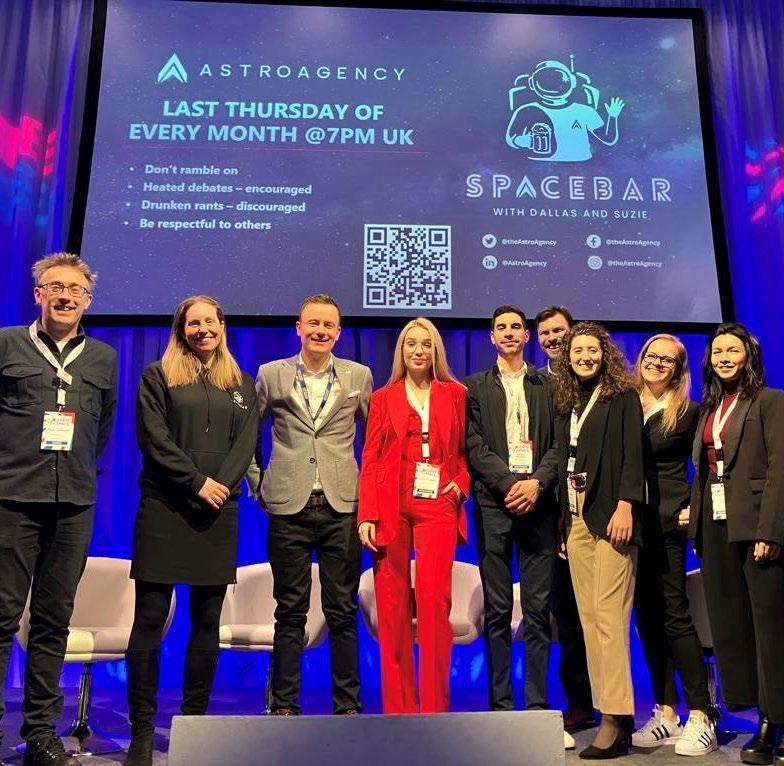
“While working in launch, I couldn’t shake the feeling that our industry needed to shout more about its worth to our economy, environment and society.”
The more people that can raise awareness in what may be the biggest challenge facing the sector, the better. People like Prof. Moriba Jah and Max Alexander have been hugely supportive of our work around this issue and I definitely class myself as a “space environmentalist” - a term coined by Moriba that I think captures the movement succinctly, while garnering interest and intrigue from those unfamiliar with the severity of the situation. That’s how good awareness raising is done!
AstroAgency’s ability to win clients and grow your team’s international presence despite the difficulties faced by Russia’s invasion of Ukraine are well documented. COO Daria Filichkina received a Sir Arthur Clark Award last year from the British Interplanetary Society in recognition of the firm’s resilience. How much does that ongoing conflict still affect the company?
We still have team members in Ukraine. Those who managed to leave the country safely, including Daria (and indeed 20 members of my wife’s family) are still impacted daily. They want to get home and the ongoing uncertainty hits every aspect of one’s life, from your finances to your mental health. Beyond team members in Ukraine, we all have friends and family there. But Daria’s speech at the ceremony said it all. Work was the one normal thing she had, so while fleeing the country with her mum, son and dog she found herself stopping for calls with our clients –much to our team’s shock – throughout her journey from Ukraine to Scotland. She didn’t want to let our clients or the sector we support down, but she also needed that focus, that constant. My daughter and Godson are Ukrainian and I sometimes wonder how we’ll ever properly explain the invasion that’s shaping their childhood.

The company has been described as a female-majority space company – how important is diversity to AstroAgency, and to the space sector?
It shows our approach of hiring the best people regardless of any factor except passion and ability is working. Our recruitment process – space marketing is a tricky skillset to find – removes pipeline blockers through inclusivity. The result happens to be female-majority for us, and the wider space sector must take this same approach. Ensure that there are no conscious or unintended blockers for technical or non-technical roles and you remove barriers to sectoral growth, that ultimately comes from new generations or people transitioning into the industry from other markets.
Bring used as an example of a female-majority space company, much like the Sir Arthur Clarke Award, also demonstrates that AstroAgency are not viewed as a marketing agency with space clients, but a space company that specialises in communications, market guidance and messaging. This is an important distinction, reflecting our company culture and commitment to supporting the space economy from the inside.
What are the company’s goals for the year ahead?
Client retention is always key. We’re moving into our third year with Euroconsult, second year with Spire, fourth year with FPGA board manufacturers Alpha Data, second year with space sustainability firm ClearSpace. Beyond that, we’ve announced our intention to expand our footprint internationally. My business partner Daria was invited to present at the Indo-Pacific Space & Earth Conference and explored some ideas in Australia. There are clear parallels between the UK and Australian space sectors, as well as the Space Bridge initiative. My sister is also based in the country and is a huge advocate for the way of life! It’s a fantastic option and we’re already growing our clients in the Gulf and Asia, so it feels like a good idea to open new bases outside of Europe.
AUSTRALIA IN SPACE 44 | Australia in Space Magazine
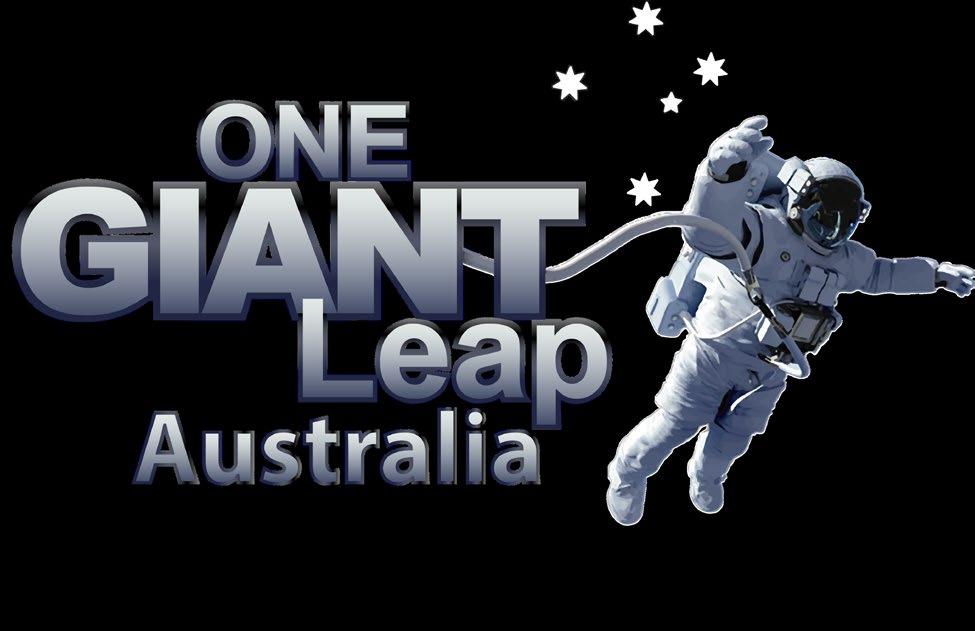
w w w . o n e g i a n t l e a p a u s t r a l i a . c o m
w w w . o n e g i a n t l e a p f o u n d a t i o n . c o m . a u
What we do What we do What we do
F o r A u s t r a l i a t o r e a c h i t s f u l l p o t e n t i a l i n S c i e n c e , T e c h n o l o g y , E n g i n e e r i n g a n d
M a t h e m a t i c s ( S T E M ) , w e n e e d t o e n s u r e w e a r e d e v e l o p i n g a f u t u r e w o r k f o r c e
e q u i p p e d w i t h t h e d i v e r s e a n d d y n a m i c s e t
o f s k i l l s t h a t w i l l m e e t t h e n e e d s o f
e m p l o y e r s i n t h e s e d e v e l o p i n g a n d i n n o v a t i v e i n d u s t r i e s
O n e G i a n t L e a p A u s t r a l i a h e l p s s c h o o l s
b u i l d a n d m a i n t a i n s t u d e n t i n t e r e s t a n d
a s p i r a t i o n i n S T E M .
O n e G i a n t L e a p Au s t r a l i a h a s f o r g e d
s t r o n g w o r k i n g r e l a t i o n s h i p s a n d p a r t n e r s h i p s w i t h a r a n g e o f e d u c a t i o n a l
i n s t i t u t i o n s a n d p r o v i d e r s ; l o c a l , s t a t e a n d
n a t i o n a l g o v e r n m e n t a g e n c i e s ; S T E M -
b a s e d c o m p a n i e s ; a e r o n a u t i c a l a n d a s t r o n o m i c a l r e s e a r c h e r s a n d s c i e n t i s t s a n d o t h e r c o m m u n i t y - b a s e d o r g a n i s a t i o n s

Key Programs
Key Programs
Key Programs
Seeds i n Space
Australian school students experiment with and cultivate seeds, such as wattle and basil, that have spend time in space on the international space station in this unique scientific study.
Connecti ng Mi nds Project
Students around the globe collaborate together to develop solutions to STEM challenges in space Students not only develop STEM skills but also key communication and collaborative skills
Gadget Gi rlz
Run by girls, for girls, this programs opens the door to young girls who want to pursue a career in STEM Free one day workshops are held across Australia
Space Teams
Former NASA Astronaut, Dr Gregory Chamitoff has developed an online platform for students to learn about and develop space missions and colonies in space Participants also have access to key industry mentors
C o n t a c t : j a c k i e @ o n e g i a n t l e a p a u s t r a l i a . c o m
Democratising access to space
Is the African space industry boom, a boom In all directions ?
 By Rorisang Moyo Space Professional & Independent Strategy Consultant
By Rorisang Moyo Space Professional & Independent Strategy Consultant
Democratising access to space holds a layered meaning.The world is redefining its values about how to carry out business ethically. The world no longer means the West. Finally, states have a chance to fully participate in the global economy across all nations and creeds. Participating in the global economy is not about being offered a seat at the table, or waiting for those who started before you to open the door and ask you to come in. In a continent of emerging space nations, every step has to be calculated and disruptive in order for them to be competitive and to compete at global level. It is about forcing the door open or creating your own room where you can own the room and open the door. In fact, build the house and own your doors.
The space industry is growing and fast. It needs quick thinkers, people who think outside of the box, big picture thinkers. If you are only thinking in terms of where you are now and what you can see,you are not ready for space business. This piece will implore readers about how Africa should occupy the space economy and the values that African strategy should strive to hold dear in the never ending task of strategy definition.
Africa’s potential is sensationalised and reduced to buzzwords such as booming and Africa needs to reap
the benefits from a world that is running and ready to do business in Africa.
This article seeks to investigate an ideal scenario for democratising space for Africa. At the end of this article, one should be able to see that where there is a gap in the global market, one does not need to look up to those who are known to have independent capacity to start the project. This article calls for an Africa that is not just full of emerging space faring nations but emerging space faring nations that are also independent in their own right and can define their own future.
Current State of Space in Africa
Presently, while there is a growth of the private industry due to the capital intensive nature of the space industry, Africa is still like the rest of the world where the government is more likely to have the financial pool to have market dominance and to provide meaningful investment. The disadvantage is the form of the space activities through offering services for free and at non competitive pricing. This has been referred to as lacking commercial bite.Simply put, governmental priorities are to have accessible services and to serve the people and this is in direct contrast to the
46 | Australia in Space Magazine
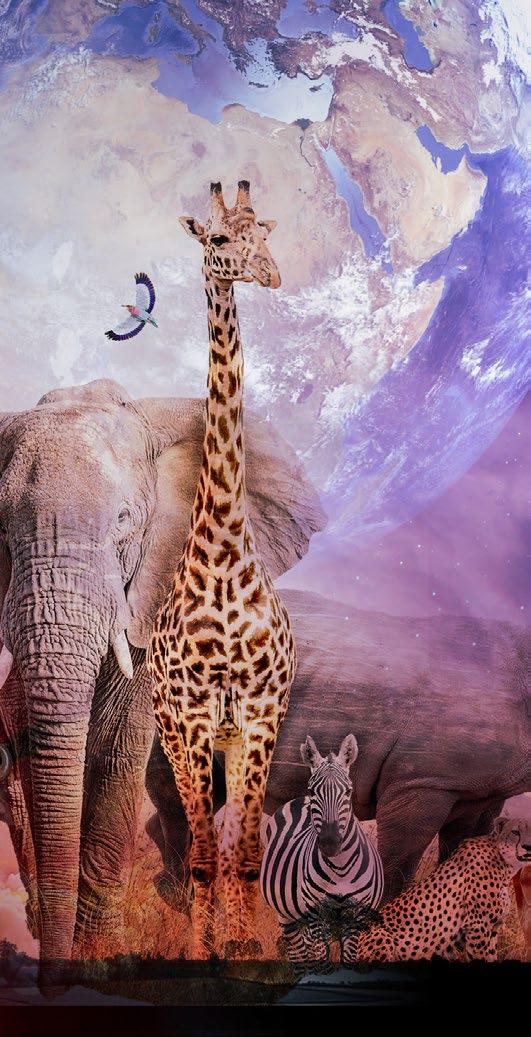
private industry which does not have the moral burden and can target clients who have the financial capacity they need. When this is considered in the bigger pool of democratising access to space, a nation that has a successful and lucrative private industry is a nation that is open to ideas and stands to profit from them. The role of government is not just to monopolise the space economy but rather to create an enabling environment thus the lack of commercial bite can be cured.
One of Africa’s space priorities is to build a connected Africa. Obviously a connected Africa means access to the rest of the world in ways that are more cost effective and affordable. It also means having access to a well of information and perspectives which means that space can be used to improve the life of the ordinary person. Most importantly it means that it opens a portal to accessing emerging technologies. Emerging technologies offer a chance to exploit the full value chain of the space industry. That is what the true democratisation of space means. The word democracy means representation in its entirety. In the next section, the article seeks to deconstruct what democratisation means through the three categories of buzzwords that should never be ignored when one is thinking of access to space within the African continent.
'This kind of thinking has led to setting limits to innovation where Africans have not used their full potential in ways such as emerging technologies to access those sectors that have been said to be out of reach.'
You cannot say an industry is booming if it's booming within very small parameters. Using the buzzwords that media uses to speak about the African space industry, the categories are critical,positive and neutral. These words are what I will use to create a picture of what a successful democratisation of space in Africa can look like in the real world.
Africa is defined as an emerging market thus the point of analysis is the critical factors that the industry should look at in order for Africa to transition from being in a perpetual state of being emerging. One of Africa’s priorities is to bridge the digital divide and the way to do that is through disruptive innovation as well as capacity building.For what will be said below to have meaning, the reader is implored to think of my proposal of how Africa can lead even though they are said to be at the bottom and emerging. To bridge a gap, one has to realise that they are already not at an equal position with space powers and have to be creative in order to bridge the gap. It is also helpful to note that Africa should also be thinking beyond capacity building and think rather of capability building. Capacity building can happen in a variety of ways, you can have the capacity to do something through another and your capacity is only enabled through that other entity. However with capability building, one develops the ability to carry out the activity independently and promotes self sufficiency.
Critical words to consider
The critical words include neo-colonialism, militarization, sustainability paradox and digital colonialism. Neocolonialism seeks to evaluate how present day African states still operate according to colonial values thus reinforcing the unequal power dynamic between them and former colonising states. Concerns that would arise would be exploitation of Africa’s resources and African talent for the benefit of space powers. True democratisation of space would have a focus on regulating Africa’s relationship with super powers to lead to a result that is mutually beneficial.
Militarisation is characterised by potential destruction and turning space into an arms race. What Africa would have to consider are the ethics behind profiting from weapons of war.In the same light expanding space services to military intelligence would be important for space security. Strategically investing in the military for the greater good such as national security would be adhering to the values of democracy where the military exists to protect the nation and the freedoms of its people. This would be a big contrast to fabricating the necessity for military
AUSTRALIA IN SPACE Australia in Space Magazine | 47
Cont next page >>
Digital colonialism is the mischaracterisation of what Africa’s industry is and what it is not through a lack of media outlets . Media influences the power of perception and has historically been used to inspire public fascination and funding allocations
intervention in order to justify defence technology in civil wars that some nations have no business getting involved in. Democratising space would be for space to be used for goods and to use it as a chance to reimagine values as we know them.
Sustainability paradox is centred around the impact of space activities on the environment and sustainable development. Africa has reflected their values and their strong stance on sustainable development in Agenda 2063, AU handbook, the Africa Free Continental Trade Agreement and the Digital Transformation strategy for Africa 2020 to 2030. These documents are sensitive to the needs of a young population as well as a population that takes the hardest fall when disaster strikes.
Digital colonialism is the mischaracterisation of what Africa’s industry is and what it is not through a lack of media outlets. Media influences the power of perception and has historically been used to inspire public fascination and funding allocations. Digital colonialism also looks like a lack of space media outlets in Africa where there is one voice and general media is left to fill in the gap. This constricts the space for reimagining the media industry in job creation and innovative solutions for the space industry. It undervalues the value of other sectors besides STEM in fully contributing to the space economy through emerging technologies. Africa should reevaluate who their space stakeholders could be.
Positive Indicators
If you find yourself at any discussion or you are listening to a speech about the African space industry and the following words do not appear. You are in a room where democratisation of space is clearly not part of the agenda.
Leapfrogging refers to the adoption of cutting edge technologies to overcome historical advantages and to adapt rapidly. What would that look like? We need to exploit our large population, to use their creativity to come up with creative and innovative solutions to Africa’s problems. This means that Africa cannot only be thinking within the parameters of what has already been created, to do that will mean they are playing it too safe and under estimating Africa’s power to Pan African collaboration will be to start forming and maintaining relationships at home. Collaborating within a continent has reaped benefits and this has been seen in Europe. Examples of these are African scholarship opportunities, knowledge sharing, tech collaborations, building consolidated knowledge hubs and the African Space Agency is in a strategic position to coordinate and lead valuable Pan African collaboration.
Participation in Newspace is a positive indicator of Africa correcting what has hurt the private industry in other parts of the world, an industry that is dominated by the government. Private industry promotes innovation and creativity, the private industry is where organisations create and think from a place of hunger and the knowledge that they have to assert their dominance through the best work.
Conclusion
Many things have always been framed as none of Africa’s business; space exploration, space mining to name a few. This kind of thinking has led to setting limits to innovation where Africans have not used their full potential in ways such as emerging technologies to access those sectors that have been said to be out of reach. If an industry is booming it has to boom in all directions because a boom cannot be quantified.

AUSTRALIA IN SPACE 48 | Australia in Space Magazine




NOVEMBER 2024 | CROWN PERTH, WESTERN AUSTRALIA BROUGHT TO YOU BY Tofindout more! www.spaceandearthconference.com RESOURCES AGRICULTURE SUSTAINABILITY SPACE ROBOTICS INVESTMENT & COMMERCIALISATION EDUCATION CRITICAL TECHNOLOGIES DEFENCE
































 By Andrew Curran Australia in Space
By Andrew Curran Australia in Space





















 Gerrit OlivierChief SCIENTIST FLEET SPACE
Peter Williams GENERAL MANAGER OF SALES SOUTHERN LAUNCH
Tim Kelly DIRECTOR MEF-SC
Simon Webster EXECUTIVE MANAGERADVANCE CAPABILITY QUEENSLAND FIRE AND EMERGENCY SERVICES
Gerrit OlivierChief SCIENTIST FLEET SPACE
Peter Williams GENERAL MANAGER OF SALES SOUTHERN LAUNCH
Tim Kelly DIRECTOR MEF-SC
Simon Webster EXECUTIVE MANAGERADVANCE CAPABILITY QUEENSLAND FIRE AND EMERGENCY SERVICES























 By Andrew Curran Australia in Space
By Andrew Curran Australia in Space























 By Rorisang Moyo Space Professional & Independent Strategy Consultant
By Rorisang Moyo Space Professional & Independent Strategy Consultant




